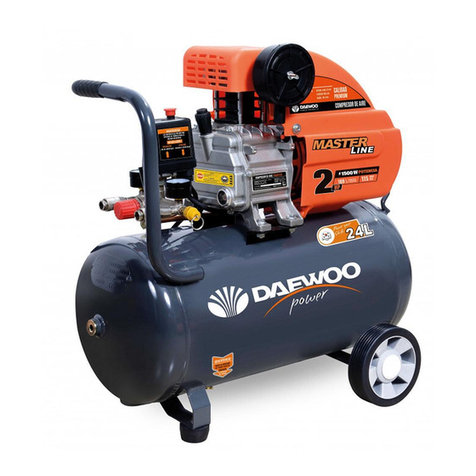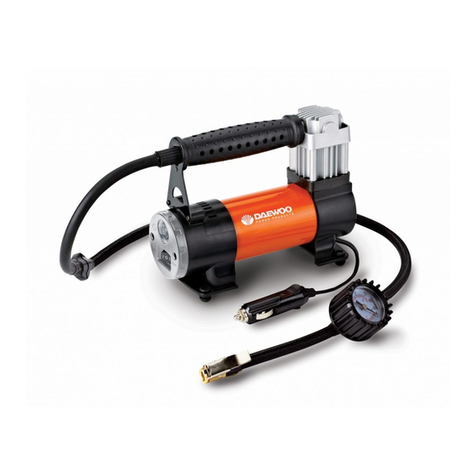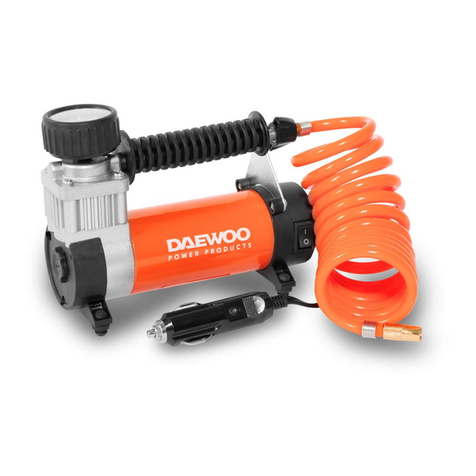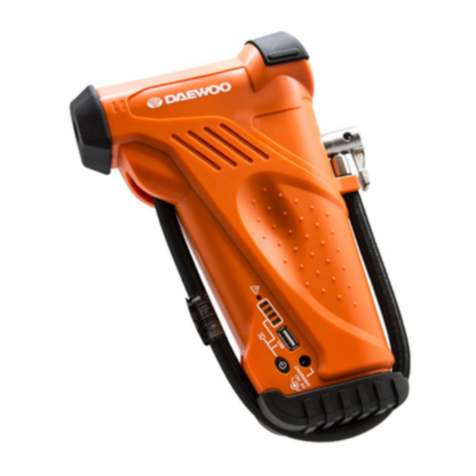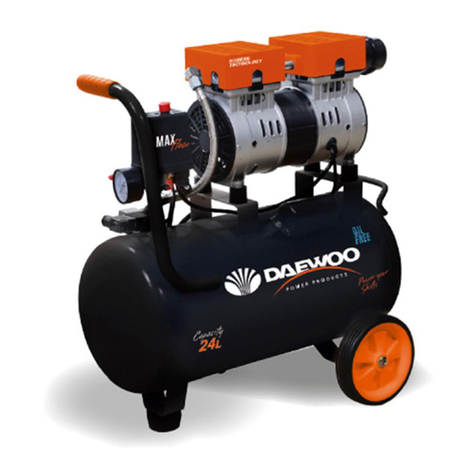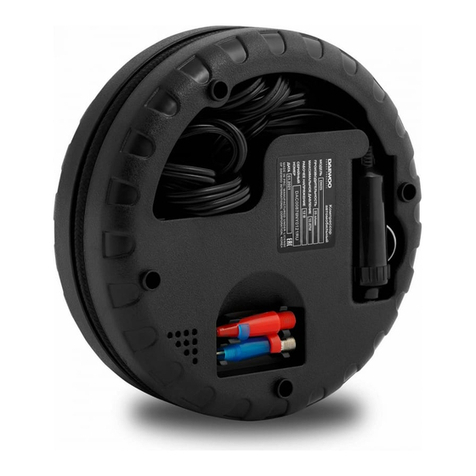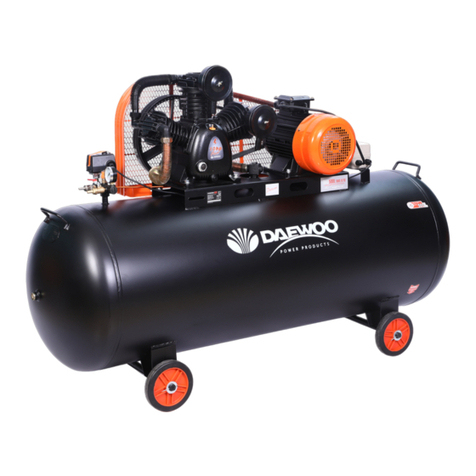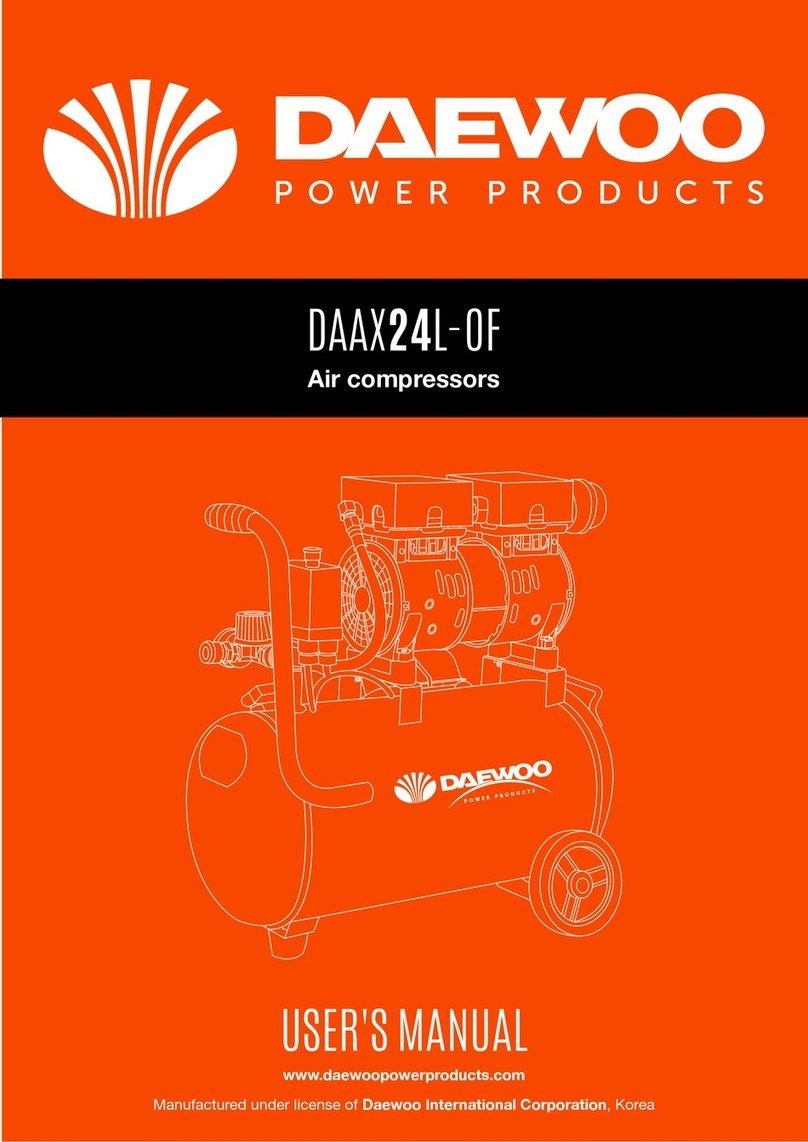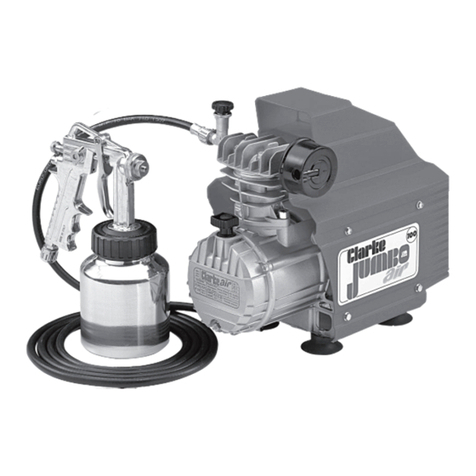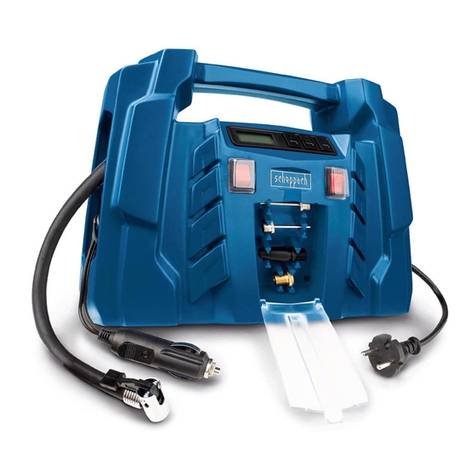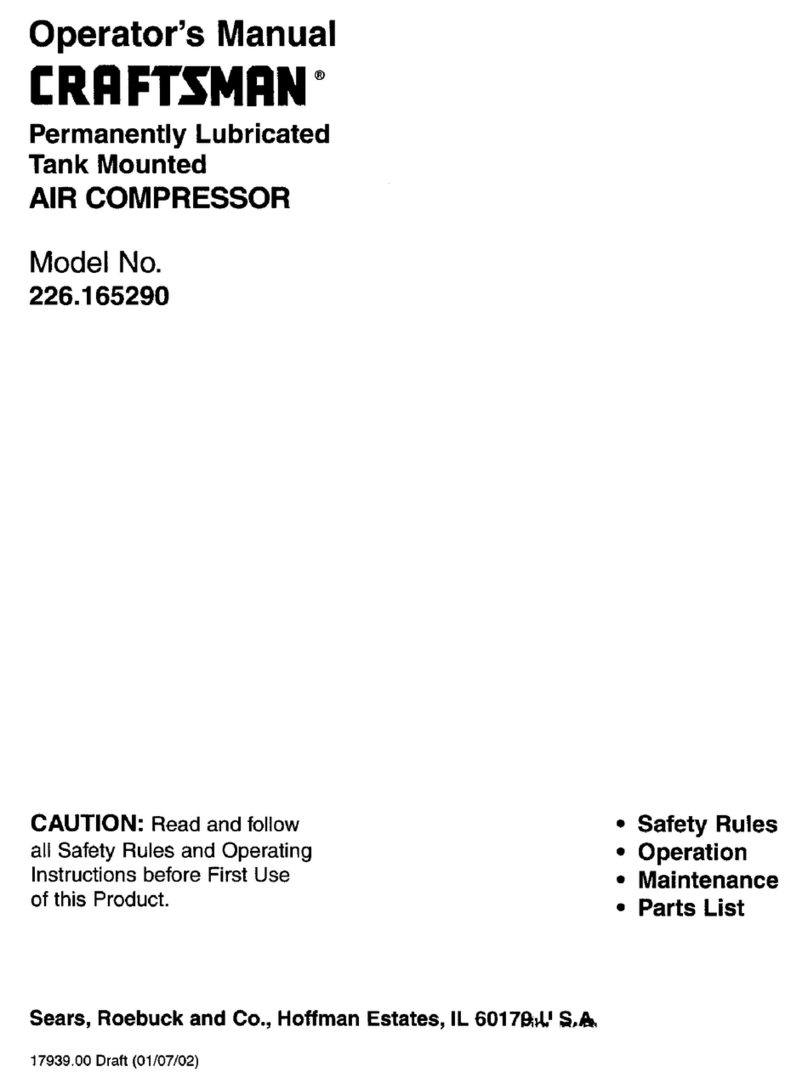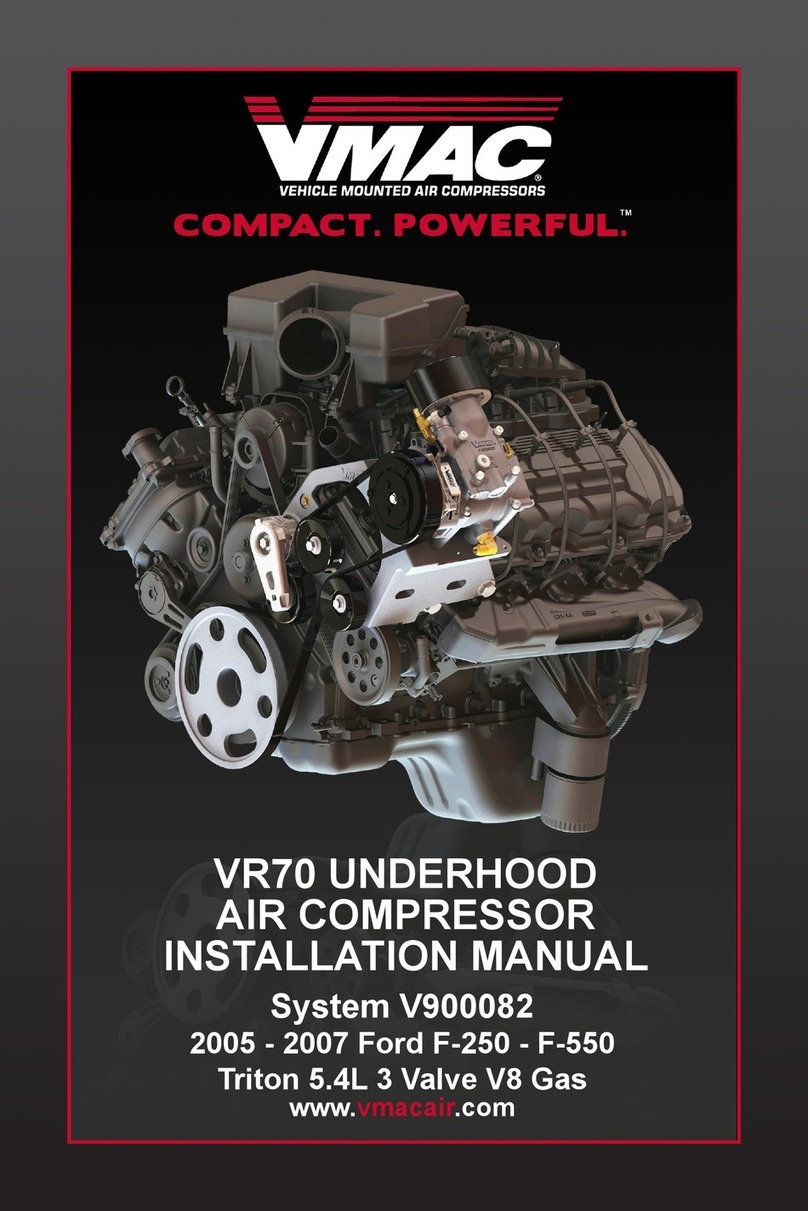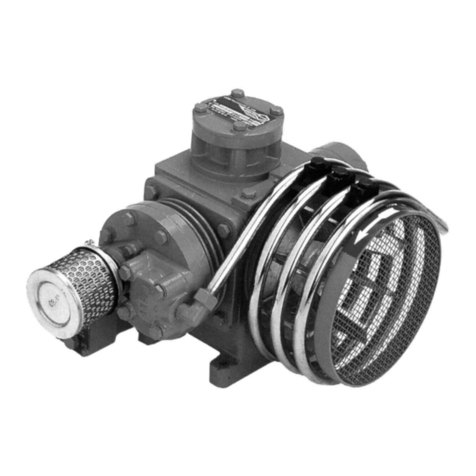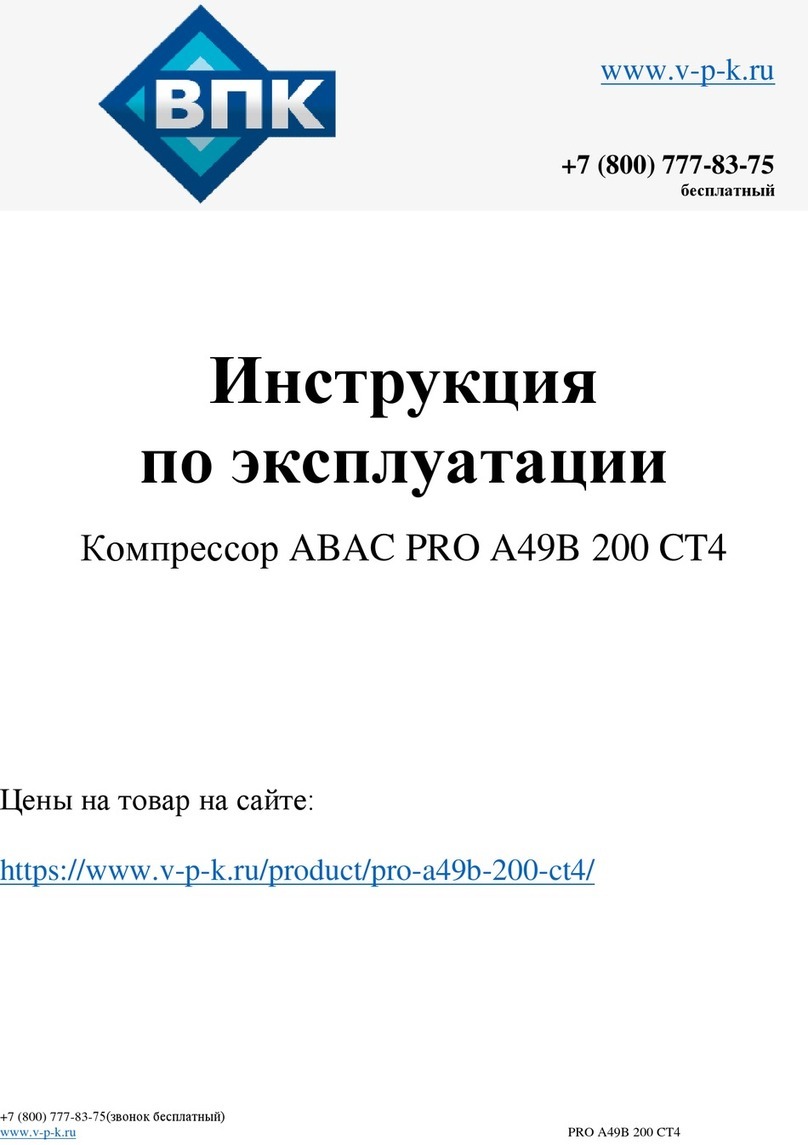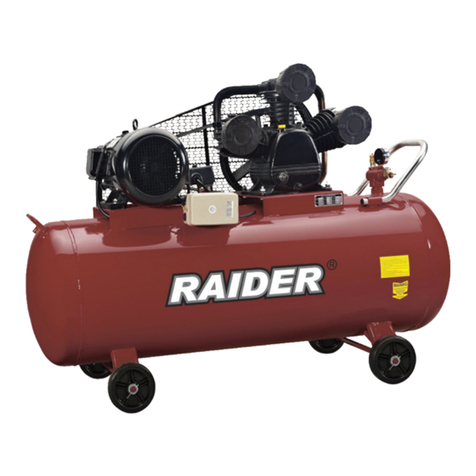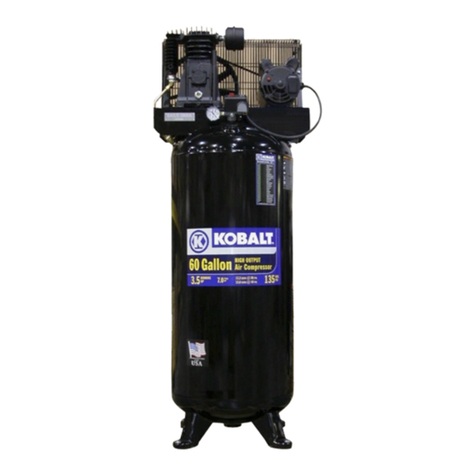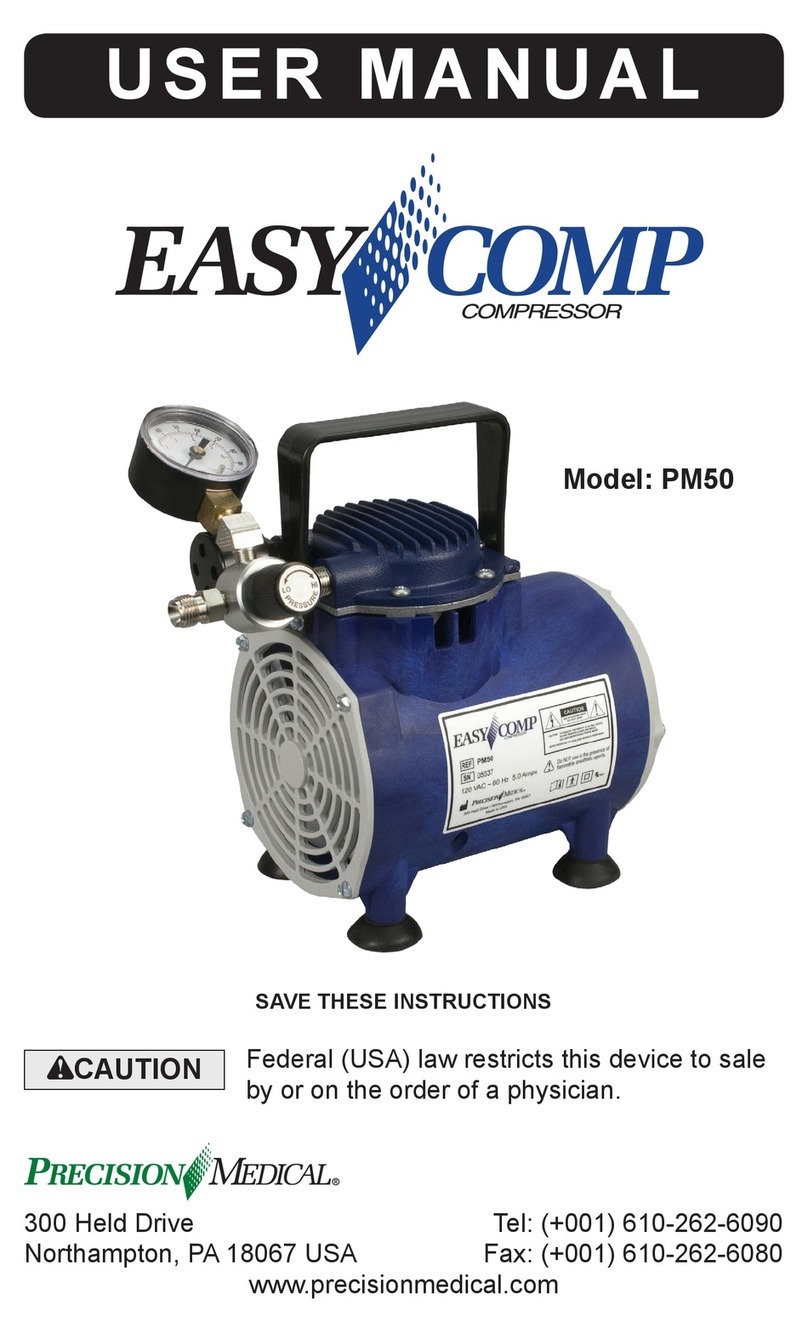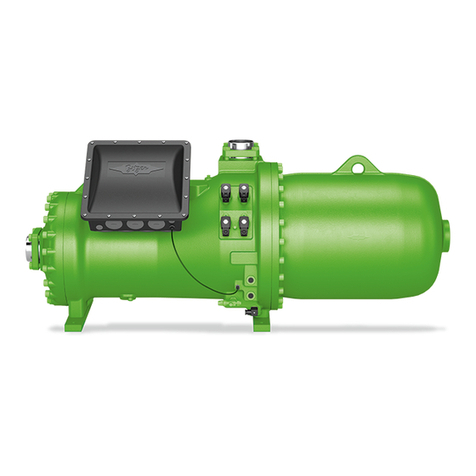Daewoo DW25 User manual

DW25 | DW40L
Car air compressor / Compresor de aire para autos
Manufactured under license of Daewoo International Corporation, Korea/
Fabricado bajo licencia de Daewoo International Corporation, Corea
www.daewoopowerproducts.com
USER'S MANUAL/ MANUAL DE USO

1
.........................................................
..........................................................
.............................................................................................................................
3. Equipo
...............................................................................................................
2. Especicaciones
......................................................................................................................
1. Introducción
4. Tipo de partes de productos y componentes de DW25
5. Tipo de partes de productos y componentes de DW40L
....................................................................................................
6. Información de seguridad
.............................................................................................................
7. Uso de la maquina
.................................................................................................................
8. Mantenimiento
.......................................................................................................
9. Solución de Problemas
.........................................................................................................................
10. Garantía
ÍNDICE
2
2
2
3
3
4
4
6
7
8
...........................................................................
...........................................................................
...........................................................................................................................
3. Equipment
........................................................................................................................
2. Specications
.........................................................................................................................
1. Introduction
4. Type of product and component parts DW25
5. Type of product and component parts DW40L
..................................................................................................................
6. Safety Information
................................................................................................................
7. Working with device
.............................................................................................................
8. Technical and support
...................................................................................................................
9. Trouble-shooting
..............................................................................................................................
10. Warranty
INDEX
9
9
9
10
10
11
11
12
13
14

2
1. INTRODUCCIÓN
Gracias por comprar el compresor para automóviles DAEWOO.
Los compresores DAEWOO están diseñados para inflar neumáticos de coche, moto, bicicletas y
material deportivo inflable. Se trata de un compresor moderno, cómodo y fácil de usar, con extendi-
do y finalización de transferencia de aguja. Será una herramienta indispensable no sólo para los
automovilistas, sino para los amantes de las actividades al aire libre y los deportes.
Este manual describe las precauciones de seguridad y procedimientos para el Compresor DAEWOO.
Todos los datos de la Guía del usuario contienen la información más reciente disponible en el
momento de la impresión. Algunos de los cambios realizados por el fabricante pueden no reflejarse
en este manual. Las imágenes y los dibujos son material sin diferencia de los productos reales.
Antes de trabajar con el compresor todo el manual se debe leer cuidadosamente. Esto ayudará a
prevenir lesiones y daños al equipo.
2. ESPECIFICACIONES
3. EQUIPO
Model o
DW25
DW40L
Compresores ,
unidades
1
1
Un conjunto de
boquillas, pcs
3
3
Tapas de repuesto
para pieza pez ón
–
4
Manual de usuario , pc
1
1
Garantía , NY
1
1
Unidad de embalaje
1
1
Modelo
DW25
DW40L
Rendimiento, l / min
25
40
Presión máxima, ATM
10
7.5
Tiempo de inado
Tamaño de rueda R15/195/60
to 2,3 АТМ, m
5
5
Tiempo de operación , min
15
20
Tensión de servicio, V
12
12
Corriente , amp
8
8
Longitud de manguera, cm
45
45
Longitud del cable , cm
300
350
Manómetro
Built-in
Removable
Luz
No
Yes
Fusible A
15
15
Tipo de conexión
Plug
Plug
Dimensiones, cm
7.5*16.7*17
22.5*9*21.5
Peso, kg
2
2.5
ES

B
G
A
C
E
F
H
D
I
J
К
3
4. TIPO DE PARTES DE PRODUCTOS Y COMPONENTES DE DW25
A
Manómetro
В
Manguera de aire
С
Conector de conexión
D
Un set de boquillas
E
Plug del cable de
alimentación
F
Botón on/o
5. TIPO DE PARTES DE PRODUCTOS Y COMPONENTES DE DW 40L
A
Manómetro digital
desmontable
В
Manguera de aire
С
Conector de conexión
D
Un set de boquillas
E
Plug del cable de
alimentación
F
Botón on/o
G
Cobertura de compresor
H
Manija del compresor
I
Cuatro t apas de repuesto
para pico de inado
J
Medidor de palanca de
bloqueo extraíble
К
Luz
A
C
BF
E
D
D

4
6. INFORMACIÓN DE SEGURIDAD
Instrucciones generales de seguridad
Lea atentamente las instrucciones antes de empezar a usar el dispositivo. La violación de las
normas de uso del dispositivo puede dar lugar a descargas eléctricas, incendios y lesiones serias.
• Guarde estas instrucciones para uso futuro.
• El compresor está diseñado para inflar coches, motos, neumáticos para bicicletas y equipamiento
deportivo inflable. No utilice el compresor para otros fines.
• Este compresor está diseñado para bombear el aire en los tanques de aire, cilindros y amortigua-
dores.
• Mantener alejado de los niños. No deje el dispositivo sin supervisión cuando los niños están cerca.
• No deje el compresor desatendido.
• No use el compresor de forma continua durante más del tiempo fijado por el fabricante (véase la
Sección 2 Especificaciones). Un trabajo más largo puede provocar un sobrecalentamiento del
compresor y su falla. Deje que el compresor se enfríe durante al menos 20 minutos antes de usarlo
de nuevo.
• No exceda la presión máxima de inflado del producto, que por lo general se indica en el neumático
del coche o el equipo deportivo.
• No utilizar el compresor en zonas de incendio o en proximidades de sustancias inflamables.
• No utilizar el compresor en lugares húmedos o mojados.
• Utilice el compresor sólo en combinación con los accesorios que acompañan.
7. USO DE LA MÁQUINA
Precaución
Este compresor ha sido diseñado para funcionar sólo con DC de 12 V. No utilice otras fuentes de
energía y no modificar el compresor.
Si la batería del coche no está suficientemente cargada, el voltaje del sistema puede no ser suficien-
te para el funcionamiento eficaz del compresor. En este caso, se recomienda utilizar el compresor
cuando el motor del vehículo esté encendido.
• No encienda el motor de un coche en un lugar mal ventilado, puede conducir a la intoxicación por
los gases de escape.
• No cargue el cable de alimentación del compresor o la manguera de aire.
• No permita que la suciedad, cenizas u otros objetos entren en la toma del encendedor. Los objetos
extraños pueden causar una falla de un contacto eléctrico fiable, causar el sobrecalentamiento de la
toma del encendedor y causar daños en el vehículo, así como lesiones y fuego.
• Cuando se utiliza un compresor, desenchúfelo de inmediato del sistema eléctrico.
1. Retire el compresor de su embalaje.
2. Desenrolle el cable de alimentación. El cable modelo DW25 se coloca en el lado posterior de la
carcasa, el cable de modelo DW40L está bajo la cubierta en el lado frontal.
3. Para preparar la manguera de aire. La manguera de aire se coloca en un compartimiento especial
en el lado de la carcasa.
4. Conecte el cable de alimentación en la toma del encendedor de 12V en el coche.
5. Conecte el conector de la manguera de aire a la bobina del neumático.
Precaución
Inflar pelotas y otros equipos utilizando la boquilla de aplicación. No utilice boquillas y otros acceso-
rios no incluidos en este compresor.
6. Apague el compresor con el botón "on / off". Continuar bombeando hasta la presión deseada.
Precaución
No exceda la presión de los neumáticos recomendada por el fabricante u otro artículo. Observe el
indicador de presión durante el funcionamiento del compresor.
7. Retire el enchufe de la toma del encendedor del vehículo.
8. Coloque con cuidado el cable de alimentación, la manguera de aire y los accesorios en los com-
partimentos de almacenamiento especiales en la carcasa del compresor.
Compresor autostop DW40L
Precaución
Antes de empezar, asegúrese de que el manómetro digital esté montado en el lugar habitual en el
compresor y la palanca de bloqueo esté firmemente sujeta.
1. Conecte el cable de alimentación en la toma del encendedor de 12V en el coche.
2. Conecte el conector de la manguera de aire a la bobina del neumático.
3. Pulse la tecla «Reset / On» en el manómetro; el medidor lee la presión de los neumáticos de un
vehículo.
4. Calibre por defecto la función de apagar el compresor hasta alcanzar la presión de los neumáticos
de 30 PSI (2,05 bar). Haga clic en el signo "+" y "-" en el indicador y establezca cualquier presión
deseada. Confirme su selección pulsando la tecla «Reset / On» en el indicador. El compresor se
detendrá automáticamente al alcanzar la presión establecida en el neumático.
5. Inicie el compresor presionando "ON / OFF". El compresor comenzará a trabajar y se detendrá a
una presión predeterminada.
6. Retire el enchufe de la toma del encendedor del vehículo.
Uso de un medidor de presión digital para el compresor DW40L
1. Levante el manómetro digital extraíble de la palanca de liberación y retire el medidor tirando hacia
arriba.
2. Pulse la tecla «Cambiar / On» en el manómetro 2 segundos hasta que el medidor indique una
presión de 0,0.
3. Presione firmemente el indicador correspondiente a los neumáticos de cola de entrada.
4. Antes de la siguiente medición, presione el botón «Reset / On» para restablecer los datos.
5. El medidor se apagará automáticamente después de 15 segundos. Para volver a utilizar, repita los
pasos 2 y 3.
Cambiar el formato de datos para medir el compresor DW40L
El manómetro extraíble digital se puede utilizar para monitorizar la presión del neumático mientras
se infla, para detener automáticamente el compresor cuando se alcanza la presión establecida, y
también se puede utilizar por separado desde el compresor como un indicador normal de la presión
digital.
Las lecturas del medidor de presión digital se pueden mostrar en diferentes unidades: PSI, BAR, KG
/ CM², KPA.
Por defecto, el indicador se establece en la producción en PSI. Para cambiar la lectura usted debe:
1. Pulse la tecla «Reset / On» en el manómetro por 2 segundos. La pantalla mostrará el indicador de
presión 0.0.
2. Mantenga pulsado el botón «Reset / On» durante 3 segundos hasta que la pantalla parpadee.
3. Pulse la tecla «Reset / On» para seleccionar las unidades deseadas: PSI, BAR, KG / CM², KPA.
4. Después de seleccionar la unidad de medición el medidor se moverá a la medida seleccionada, el
nombre de las unidades se mostrará en letras pequeñas en la parte superior de la pantalla.
5. Obsérvese que en el proceso de inflar, el indicador de presión que muestra la presión en el neu-
mático no es como en la manguera de aire. La presión en la manguera en 1-2 PSI puede diferir de la
presión en la cámara de la rueda.
6. Si la presión no se eleva por encima de 3 PSI (daño significativo a la rueda de la cámara) en 15
segundos encender el compresor.
7. El medidor de energía está hecho a partir de 2 pilas LR44 estándar. Cuando la capacidad de la
batería será insuficiente, la pantalla indicará el medidor.
Para reemplazar las baterías, desenroscar el tornillo en la parte posterior del medidor.
8. MANTENIMIENTO
Antes de realizar cualquier trabajo de mantenimiento, asegúrese de que el compresor se desconecte
de la fuente de alimentación. Realizar únicamente los trabajos de mantenimiento descritos en las
instrucciones de funcionamiento.
Sobre la aplicación de todos los demás trabajos, póngase en contacto con un centro de servicio
autorizado DAEWOO.
Recomendaciones para el mantenimiento
• Después de cada uso, limpie la suciedad del compresor. Para limpiar la manguera use un paño
húmedo. No utilice disolventes ni objetos afilados.
• Antes de un almacenamiento a largo plazo, para evitar la corrosión, cubra todas las partes metáli-
cas lubricadas.
• Revise periódicamente la integridad y fiabilidad del cable y la manguera.
Precaución
Para un uso seguro de los compresores equipados con un fusible (Fig. 1).
Para reemplazar el fusible, en caso de agotamiento, retírelo aflojando la parte final de la clavija de
alimentación e inserte un fusible nuevo.
ES

5
6. INFORMACIÓN DE SEGURIDAD
Instrucciones generales de seguridad
Lea atentamente las instrucciones antes de empezar a usar el dispositivo. La violación de las
normas de uso del dispositivo puede dar lugar a descargas eléctricas, incendios y lesiones serias.
• Guarde estas instrucciones para uso futuro.
• El compresor está diseñado para inflar coches, motos, neumáticos para bicicletas y equipamiento
deportivo inflable. No utilice el compresor para otros fines.
• Este compresor está diseñado para bombear el aire en los tanques de aire, cilindros y amortigua-
dores.
• Mantener alejado de los niños. No deje el dispositivo sin supervisión cuando los niños están cerca.
• No deje el compresor desatendido.
• No use el compresor de forma continua durante más del tiempo fijado por el fabricante (véase la
Sección 2 Especificaciones). Un trabajo más largo puede provocar un sobrecalentamiento del
compresor y su falla. Deje que el compresor se enfríe durante al menos 20 minutos antes de usarlo
de nuevo.
• No exceda la presión máxima de inflado del producto, que por lo general se indica en el neumático
del coche o el equipo deportivo.
• No utilizar el compresor en zonas de incendio o en proximidades de sustancias inflamables.
• No utilizar el compresor en lugares húmedos o mojados.
• Utilice el compresor sólo en combinación con los accesorios que acompañan.
7. USO DE LA MÁQUINA
Precaución
Este compresor ha sido diseñado para funcionar sólo con DC de 12 V. No utilice otras fuentes de
energía y no modificar el compresor.
Si la batería del coche no está suficientemente cargada, el voltaje del sistema puede no ser suficien-
te para el funcionamiento eficaz del compresor. En este caso, se recomienda utilizar el compresor
cuando el motor del vehículo esté encendido.
• No encienda el motor de un coche en un lugar mal ventilado, puede conducir a la intoxicación por
los gases de escape.
• No cargue el cable de alimentación del compresor o la manguera de aire.
• No permita que la suciedad, cenizas u otros objetos entren en la toma del encendedor. Los objetos
extraños pueden causar una falla de un contacto eléctrico fiable, causar el sobrecalentamiento de la
toma del encendedor y causar daños en el vehículo, así como lesiones y fuego.
• Cuando se utiliza un compresor, desenchúfelo de inmediato del sistema eléctrico.
1. Retire el compresor de su embalaje.
2. Desenrolle el cable de alimentación. El cable modelo DW25 se coloca en el lado posterior de la
carcasa, el cable de modelo DW40L está bajo la cubierta en el lado frontal.
3. Para preparar la manguera de aire. La manguera de aire se coloca en un compartimiento especial
en el lado de la carcasa.
4. Conecte el cable de alimentación en la toma del encendedor de 12V en el coche.
5. Conecte el conector de la manguera de aire a la bobina del neumático.
Precaución
Inflar pelotas y otros equipos utilizando la boquilla de aplicación. No utilice boquillas y otros acceso-
rios no incluidos en este compresor.
6. Apague el compresor con el botón "on / off". Continuar bombeando hasta la presión deseada.
Precaución
No exceda la presión de los neumáticos recomendada por el fabricante u otro artículo. Observe el
indicador de presión durante el funcionamiento del compresor.
7. Retire el enchufe de la toma del encendedor del vehículo.
8. Coloque con cuidado el cable de alimentación, la manguera de aire y los accesorios en los com-
partimentos de almacenamiento especiales en la carcasa del compresor.
Compresor autostop DW40L
Precaución
Antes de empezar, asegúrese de que el manómetro digital esté montado en el lugar habitual en el
compresor y la palanca de bloqueo esté firmemente sujeta.
1. Conecte el cable de alimentación en la toma del encendedor de 12V en el coche.
2. Conecte el conector de la manguera de aire a la bobina del neumático.
3. Pulse la tecla «Reset / On» en el manómetro; el medidor lee la presión de los neumáticos de un
vehículo.
4. Calibre por defecto la función de apagar el compresor hasta alcanzar la presión de los neumáticos
de 30 PSI (2,05 bar). Haga clic en el signo "+" y "-" en el indicador y establezca cualquier presión
deseada. Confirme su selección pulsando la tecla «Reset / On» en el indicador. El compresor se
detendrá automáticamente al alcanzar la presión establecida en el neumático.
5. Inicie el compresor presionando "ON / OFF". El compresor comenzará a trabajar y se detendrá a
una presión predeterminada.
6. Retire el enchufe de la toma del encendedor del vehículo.
Uso de un medidor de presión digital para el compresor DW40L
1. Levante el manómetro digital extraíble de la palanca de liberación y retire el medidor tirando hacia
arriba.
2. Pulse la tecla «Cambiar / On» en el manómetro 2 segundos hasta que el medidor indique una
presión de 0,0.
3. Presione firmemente el indicador correspondiente a los neumáticos de cola de entrada.
4. Antes de la siguiente medición, presione el botón «Reset / On» para restablecer los datos.
5. El medidor se apagará automáticamente después de 15 segundos. Para volver a utilizar, repita los
pasos 2 y 3.
Cambiar el formato de datos para medir el compresor DW40L
El manómetro extraíble digital se puede utilizar para monitorizar la presión del neumático mientras
se infla, para detener automáticamente el compresor cuando se alcanza la presión establecida, y
también se puede utilizar por separado desde el compresor como un indicador normal de la presión
digital.
Las lecturas del medidor de presión digital se pueden mostrar en diferentes unidades: PSI, BAR, KG
/ CM², KPA.
Por defecto, el indicador se establece en la producción en PSI. Para cambiar la lectura usted debe:
1. Pulse la tecla «Reset / On» en el manómetro por 2 segundos. La pantalla mostrará el indicador de
presión 0.0.
2. Mantenga pulsado el botón «Reset / On» durante 3 segundos hasta que la pantalla parpadee.
3. Pulse la tecla «Reset / On» para seleccionar las unidades deseadas: PSI, BAR, KG / CM², KPA.
4. Después de seleccionar la unidad de medición el medidor se moverá a la medida seleccionada, el
nombre de las unidades se mostrará en letras pequeñas en la parte superior de la pantalla.
5. Obsérvese que en el proceso de inflar, el indicador de presión que muestra la presión en el neu-
mático no es como en la manguera de aire. La presión en la manguera en 1-2 PSI puede diferir de la
presión en la cámara de la rueda.
6. Si la presión no se eleva por encima de 3 PSI (daño significativo a la rueda de la cámara) en 15
segundos encender el compresor.
7. El medidor de energía está hecho a partir de 2 pilas LR44 estándar. Cuando la capacidad de la
batería será insuficiente, la pantalla indicará el medidor.
Para reemplazar las baterías, desenroscar el tornillo en la parte posterior del medidor.
8. MANTENIMIENTO
Antes de realizar cualquier trabajo de mantenimiento, asegúrese de que el compresor se desconecte
de la fuente de alimentación. Realizar únicamente los trabajos de mantenimiento descritos en las
instrucciones de funcionamiento.
Sobre la aplicación de todos los demás trabajos, póngase en contacto con un centro de servicio
autorizado DAEWOO.
Recomendaciones para el mantenimiento
• Después de cada uso, limpie la suciedad del compresor. Para limpiar la manguera use un paño
húmedo. No utilice disolventes ni objetos afilados.
• Antes de un almacenamiento a largo plazo, para evitar la corrosión, cubra todas las partes metáli-
cas lubricadas.
• Revise periódicamente la integridad y fiabilidad del cable y la manguera.
Precaución
Para un uso seguro de los compresores equipados con un fusible (Fig. 1).
Para reemplazar el fusible, en caso de agotamiento, retírelo aflojando la parte final de la clavija de
alimentación e inserte un fusible nuevo.

6
6. INFORMACIÓN DE SEGURIDAD
Instrucciones generales de seguridad
Lea atentamente las instrucciones antes de empezar a usar el dispositivo. La violación de las
normas de uso del dispositivo puede dar lugar a descargas eléctricas, incendios y lesiones serias.
• Guarde estas instrucciones para uso futuro.
• El compresor está diseñado para inflar coches, motos, neumáticos para bicicletas y equipamiento
deportivo inflable. No utilice el compresor para otros fines.
• Este compresor está diseñado para bombear el aire en los tanques de aire, cilindros y amortigua-
dores.
• Mantener alejado de los niños. No deje el dispositivo sin supervisión cuando los niños están cerca.
• No deje el compresor desatendido.
• No use el compresor de forma continua durante más del tiempo fijado por el fabricante (véase la
Sección 2 Especificaciones). Un trabajo más largo puede provocar un sobrecalentamiento del
compresor y su falla. Deje que el compresor se enfríe durante al menos 20 minutos antes de usarlo
de nuevo.
• No exceda la presión máxima de inflado del producto, que por lo general se indica en el neumático
del coche o el equipo deportivo.
• No utilizar el compresor en zonas de incendio o en proximidades de sustancias inflamables.
• No utilizar el compresor en lugares húmedos o mojados.
• Utilice el compresor sólo en combinación con los accesorios que acompañan.
7. USO DE LA MÁQUINA
Precaución
Este compresor ha sido diseñado para funcionar sólo con DC de 12 V. No utilice otras fuentes de
energía y no modificar el compresor.
Si la batería del coche no está suficientemente cargada, el voltaje del sistema puede no ser suficien-
te para el funcionamiento eficaz del compresor. En este caso, se recomienda utilizar el compresor
cuando el motor del vehículo esté encendido.
• No encienda el motor de un coche en un lugar mal ventilado, puede conducir a la intoxicación por
los gases de escape.
• No cargue el cable de alimentación del compresor o la manguera de aire.
• No permita que la suciedad, cenizas u otros objetos entren en la toma del encendedor. Los objetos
extraños pueden causar una falla de un contacto eléctrico fiable, causar el sobrecalentamiento de la
toma del encendedor y causar daños en el vehículo, así como lesiones y fuego.
• Cuando se utiliza un compresor, desenchúfelo de inmediato del sistema eléctrico.
1. Retire el compresor de su embalaje.
2. Desenrolle el cable de alimentación. El cable modelo DW25 se coloca en el lado posterior de la
carcasa, el cable de modelo DW40L está bajo la cubierta en el lado frontal.
3. Para preparar la manguera de aire. La manguera de aire se coloca en un compartimiento especial
en el lado de la carcasa.
4. Conecte el cable de alimentación en la toma del encendedor de 12V en el coche.
5. Conecte el conector de la manguera de aire a la bobina del neumático.
Precaución
Inflar pelotas y otros equipos utilizando la boquilla de aplicación. No utilice boquillas y otros acceso-
rios no incluidos en este compresor.
6. Apague el compresor con el botón "on / off". Continuar bombeando hasta la presión deseada.
Precaución
No exceda la presión de los neumáticos recomendada por el fabricante u otro artículo. Observe el
indicador de presión durante el funcionamiento del compresor.
7. Retire el enchufe de la toma del encendedor del vehículo.
8. Coloque con cuidado el cable de alimentación, la manguera de aire y los accesorios en los com-
partimentos de almacenamiento especiales en la carcasa del compresor.
Compresor autostop DW40L
Precaución
Antes de empezar, asegúrese de que el manómetro digital esté montado en el lugar habitual en el
compresor y la palanca de bloqueo esté firmemente sujeta.
1. Conecte el cable de alimentación en la toma del encendedor de 12V en el coche.
2. Conecte el conector de la manguera de aire a la bobina del neumático.
3. Pulse la tecla «Reset / On» en el manómetro; el medidor lee la presión de los neumáticos de un
vehículo.
4. Calibre por defecto la función de apagar el compresor hasta alcanzar la presión de los neumáticos
de 30 PSI (2,05 bar). Haga clic en el signo "+" y "-" en el indicador y establezca cualquier presión
deseada. Confirme su selección pulsando la tecla «Reset / On» en el indicador. El compresor se
detendrá automáticamente al alcanzar la presión establecida en el neumático.
5. Inicie el compresor presionando "ON / OFF". El compresor comenzará a trabajar y se detendrá a
una presión predeterminada.
6. Retire el enchufe de la toma del encendedor del vehículo.
Uso de un medidor de presión digital para el compresor DW40L
1. Levante el manómetro digital extraíble de la palanca de liberación y retire el medidor tirando hacia
arriba.
2. Pulse la tecla «Cambiar / On» en el manómetro 2 segundos hasta que el medidor indique una
presión de 0,0.
3. Presione firmemente el indicador correspondiente a los neumáticos de cola de entrada.
4. Antes de la siguiente medición, presione el botón «Reset / On» para restablecer los datos.
5. El medidor se apagará automáticamente después de 15 segundos. Para volver a utilizar, repita los
pasos 2 y 3.
Cambiar el formato de datos para medir el compresor DW40L
El manómetro extraíble digital se puede utilizar para monitorizar la presión del neumático mientras
se infla, para detener automáticamente el compresor cuando se alcanza la presión establecida, y
también se puede utilizar por separado desde el compresor como un indicador normal de la presión
digital.
Las lecturas del medidor de presión digital se pueden mostrar en diferentes unidades: PSI, BAR, KG
/ CM², KPA.
Por defecto, el indicador se establece en la producción en PSI. Para cambiar la lectura usted debe:
1. Pulse la tecla «Reset / On» en el manómetro por 2 segundos. La pantalla mostrará el indicador de
presión 0.0.
2. Mantenga pulsado el botón «Reset / On» durante 3 segundos hasta que la pantalla parpadee.
3. Pulse la tecla «Reset / On» para seleccionar las unidades deseadas: PSI, BAR, KG / CM², KPA.
4. Después de seleccionar la unidad de medición el medidor se moverá a la medida seleccionada, el
nombre de las unidades se mostrará en letras pequeñas en la parte superior de la pantalla.
5. Obsérvese que en el proceso de inflar, el indicador de presión que muestra la presión en el neu-
mático no es como en la manguera de aire. La presión en la manguera en 1-2 PSI puede diferir de la
presión en la cámara de la rueda.
6. Si la presión no se eleva por encima de 3 PSI (daño significativo a la rueda de la cámara) en 15
segundos encender el compresor.
7. El medidor de energía está hecho a partir de 2 pilas LR44 estándar. Cuando la capacidad de la
batería será insuficiente, la pantalla indicará el medidor.
Para reemplazar las baterías, desenroscar el tornillo en la parte posterior del medidor.
8. MANTENIMIENTO
Antes de realizar cualquier trabajo de mantenimiento, asegúrese de que el compresor se desconecte
de la fuente de alimentación. Realizar únicamente los trabajos de mantenimiento descritos en las
instrucciones de funcionamiento.
Sobre la aplicación de todos los demás trabajos, póngase en contacto con un centro de servicio
autorizado DAEWOO.
Recomendaciones para el mantenimiento
• Después de cada uso, limpie la suciedad del compresor. Para limpiar la manguera use un paño
húmedo. No utilice disolventes ni objetos afilados.
• Antes de un almacenamiento a largo plazo, para evitar la corrosión, cubra todas las partes metáli-
cas lubricadas.
• Revise periódicamente la integridad y fiabilidad del cable y la manguera.
Precaución
Para un uso seguro de los compresores equipados con un fusible (Fig. 1).
Para reemplazar el fusible, en caso de agotamiento, retírelo aflojando la parte final de la clavija de
alimentación e inserte un fusible nuevo.
(Fig. 1)
El fabricante no se hace responsable de los daños y perjuicios causados por el incumplimiento de la
seguridad y el mantenimiento.
Esto se aplica principalmente a:
• El uso de los productos para otros fines,
• Realización independiente de los cambios de diseño técnico y de producto,
• Daños consecuentes que resulten del uso de productos con componentes defectuosos,
• Daños por corrosión y otras consecuencias de almacenamiento inadecuado,
• Daños y consecuencias derivadas de la utilización de recambios no originales,
• Daños debido a trabajos de reparación y mantenimiento, que se llevaron a cabo por personal no
autorizado.
ES

7
Mal funcionami ento
Causa posible
Solución
Compresor no incluido
La fuente de alimentación
produce un voltaje de
menos de 10 V
Compruebe y sustituya / recargar la
fuente de alimentación
La fuente de alimentación
proporciona una corriente
de menos de 10 A
Fusible fundido
Reemplace el fusible de acuerdo con
el consumo máximo de corriente
Motor sobrecalentado
Deje el compresor apagado por un
período no inferior a 20 minutos
El ujo de aire se reduce
signicativamente,
bombeo a una alta
presión no pueden
Válvula de salida
desgastado o manguera
Póngase en contacto con un centro de
servicio autorizado
Hay fugas en las
articulaciones de la
manguera
Compruebe la conexión del conector
de los neumáticos del huso
Válvula extraíble de
presión del modelo
DW40L
no incluid a
Descarga de las pilas
Reemplace la batería quitando el
tornillo en la parte posterior del
medidor.
9. SOLUCIÓN DE PROBLEMAS

6. SAFETY INFORMATION
General safety instructions
Carefully read the instructions before you start using the device. Violation of rules of use of the
device may lead to electric shock, fire and serious injury.
• Keep these instructions for future use.
• The compressor is designed to inflate car, motorcycle, bicycle tires and inflatable sports equip-
ment. Do not use the compressor for other purposes.
• This compressor is designed to pump air into the air tanks, cylinders and shock absorbers.
• Keep away from children! Do not leave the device unattended when children are nearby.
• Do not leave the compressor unattended.
• Do not use the compressor continuously for more than the time set by the manufacturer (see
Section 2 Specifications). Longer work can lead to overheating of the compressor and its failure.
Allow the compressor to cool for at least 20 minutes before using it again.
• Do not exceed the maximum inflation pressure of the product, which is usually indicated on the tire
of the car or sporting equipment.
• Do not use the compressor in fire zones or in proximities of flammable substances.
• Do not use the compressor in damp or wet conditions.
• Use the compressor only in conjunction with the accompanying accessories.
7. USING THE MACHINE
Caution
This compressor is designed to work only on DC 12 V. Do not use any other power sources and do
not modify the compressor.
If your car battery is not sufficiently charged, the system voltage may not be sufficient for the effecti-
ve operation of the compressor. In this case, it is recommended to use the compressor when the
engine of the car on.
• Do not turn on the car engine in a poorly ventilated room, it can lead to poisoning by exhaust
fumes!
• Do not carry the compressor power cord or air hose.
• Do not allow dirt, ashes or other objects into the cigarette lighter socket. Foreign objects can cause
a failure of a reliable electrical contact, cause overheating of the cigarette lighter socket and cause
damage to the vehicle, injury and fire.
• When using a compressor, immediately unplug it from the electrical system.
1. Remove the compressor from its packaging.
2. Unwind the power cord. The model DW25 cord is placed on the rear side of the housing, the model
DW40L cord is under the cover on the front side.
3. Prepare for the air hose. The air hose is placed in a special compartment on the side of the hou-
sing.
4. Plug the power cord into the 12V cigarette lighter socket in the car.
5. Connect the air hose connector to the spool of the tire.
Caution
To inflate balls and other equipment, use the application nozzle. Do not use nozzles and other acces-
sories not included with this compressor.
6. Switch off the compressor button "on / off". Continue pumping until the desired pressure.
Caution
Do not exceed the recommended manufacturer tire pressure or other article! Watch the pressure
gauge during operation of the compressor.
7. Remove the power plug from the cigarette lighter socket of the vehicle.
8. Carefully place the power cord, air hose and accessories in the special storage compartments in
the compressor housing.
Autostop compressor DW40L
Caution
Before you begin, make sure that the digital pressure gauge is mounted on the regular place in the
compressor and securely fastened locking lever.
1. Plug the power cord into the 12V cigarette lighter socket in the car.
2. Connect the connector of the air hose to the spool of the tire.
3. Press the «Reset / On» on the pressure gauge; gauge reads the tire pressure of a vehicle.
4. Default gauge set to turn off the compressor reaches the tire pressure of 30 PSI (2,05 bar). Click
the "+" and "-" on the gauge and set any desired pressure. Confirm your selection by pressing the
«Reset / On» on the gauge. The compressor will stop automatically upon reaching the set pressure
in the tire.
5. Start the compressor by pressing "ON / OFF". Compressor will start to work and stops at a prede-
termined pressure.
6. Remove the power plug from the cigarette lighter socket of the vehicle.
Using a digital pressure gauge for compressor DW40L
1. Raise the release lever removable digital pressure gauge and remove the gauge by pulling it up.
2. Press the «Reset / On» on the pressure gauge. 2 seconds gauge indicates a pressure of 0.0.
3. Firmly press the gauge corresponding to the input spool tires.
4. Before the next measurement press the «Reset / On» to reset the data.
5. The gauge will automatically turn off after 15 seconds. To re-use, repeat steps 2 and 3.
Change the data format to gauge compressor DW40L
Digital removable pressure gauge can be used to monitorize tire pressure while inflating it, to auto-
matically stop the compressor when it reaches the set pressure, and also be used separately from
the compressor as a normal digital pressure gauge.
Digital pressure gauge readings can be displayed in different units: PSI, BAR, KG / CM², KPA.
By default, the gauge is set to output in PSI. To change the reading you should:
1. Press the «Reset / On» on the pressure gauge for 2 seconds, and the display will show the pressu-
re gauge 0.0.
2. Hold down the «Reset / On» button for 3 seconds until the display is blink.
3. Press the «Reset / On» to select the desired units: PSI, BAR, KG / CM², KPA.
4. After you select the unit of measurement gauge, it will move to the selected measurement and the
name of the units will be displayed in small letters at the top of the display.
5. Note that in the process of inflating, the pressure gauge shows that the pressure in the tire is not
as in the air hose. The pressure in the hose at 1-2 PSI may differ from the pressure in the chamber of
the wheel.
6. If the tire pressure does not rise above 3 PSI (significant damage to the camera wheel) within 15
seconds turn the compressor off.
7. Power gauge made from 2 standard batteries LR44. When the battery capacity will be insufficient,
the display will indicate the gauge.
To replace the batteries, unscrew the screw on the back of the gauge.
8. MAINTENANCE
Before carrying out any maintenance work, make sure that the compressor is disconnected from the
power supply. Perform only the maintenance work described in the operating instructions.
On the issue of implementation of all other works, contact an authorized service center
Recommendations for maintenance
• After each use, remove any dirt from the compressor. To clean the housing use a damp cloth. Do
not use solvents or sharp objects.
• Before long-term storage, to prevent corrosion, coat all metal parts lubricated.
• Periodically check the integrity and reliability of cable and hose.
Caution
For safe use of compressors equipped with a fuse (Fig. 1).
To replace the fuse, in case of burnout, remove it by loosening the final part of the power plug and
insert a new fuse.
Warranty conditions
The manufacturer is not responsible for any damage and damage caused by failure of the safety and
maintenance.
This primarily applies to:
• Use of products for other purposes,
• Independent realization of technical and product design changes,
• Consequential damages resulting from the use of products with defective components,
• Corrosion damage and other consequences of improper storage,
• Damages and consequences resulting from the use of non-original spare parts,
• Damage due to maintenance work and repairs, which were carried out by unauthorized personnel.
9. TROUBLESHOOTING
GARANTÍA
LA GARANTÍA NO CUBRE
Modelo del producto
Número de Serie
Nombre de usuario
Fecha de venta
Empresa
Firma del cliente
El período de garantía comienza desde la fecha de venta del producto y cubre 2 años para todos los productos.
Durante el período de garantía se eliminan los fallos causados por el uso de materiales de mala calidad en la producción
y mano de obra cuya culpa sea admitida por el fabricante. La garantía entra en vigor desde que se llenó correctamente la
tarjeta de garantía y cupones de corte. El producto es aceptado para su reparación en su forma pura y plena integridad.
• Daños mecánicos (grietas, astillas, etc.) y daños causados por
la exposición a medios agresivos, objetos extraños dentro de la
unidad y las rejillas de ventilación, así como de los daños
producidos como consecuencia de un almacenamiento
inadecuado (corrosión de las partes metálicas);
• Fallos causados por sobrecarga o mal uso del producto, el uso
del producto para otros nes, así como la inestabilidad de la
electricidad. Una señal segura de que los productos de
sobrecarga se están derritiendo o decolorando las piezas
debido a la alta temperatura son el fallo simultáneo de dos o
más nodos, el sumario sobre la supercie del cilindro y el
pistón, y la destrucción de los anillos de pistón. Además, la
garantía no cubre fallas de reguladores de energía de tensión
automáticos debido a la operación incorrecta;
• Fallos causados por la obstrucción de los sistemas de
combustible y refrigeración;
• Para piezas de desgaste (escobillas de carbón, correas, juntas
de goma, sellos de aceite, amortiguadores, resortes, embragues,
bujías, bufandas, boquillas, poleas, rodillos guía, cables de
arranque de retroceso, platos, mandriles, baterías extraíbles,
ltros y seguridad elementos, grasa, dispositivos extraíbles,
equipos, cuchillos, taladros, etc.);
• Los cables eléctricos con daños mecánicos y térmicos;
• El producto, si fue abierto o reparado fuera del Centro de
Servicio Autorizado.
• la prevención, productos de cuidado (limpieza, lavado,
lubricación, etc.), la instalación y conguración del producto;
• Los productos de desgaste natural (cuota de producción);
• Fallos causados por el uso del producto para las necesidades
relacionadas con las actividades empresariales;
• Si la tarjeta de garantía está vacía o el sello del Vendedor
faltante;
• Ausencia de la rma del titular de la tarjeta de garantía.
TARJETA DE GARANTÍA
Producto
Modelo
Empresa
Fecha
de Venta
Producto
Modelo
Empresa
Fecha
de Venta
Producto
Modelo
Empresa
Fecha
de Venta
El producto está en buenas condiciones y completo. Lea y acepte los términos de la garantía.

9
1. INTRODUCTION
Thank you for purchasing the automobile compressor DAEWOO.
DAEWOO compressors are designed to inflate car, motorcycle, bicycle tires, and inflatable sports
equipment. Modern, convenient and easy-to-use compressor with extended completion need-
le-transfer will be an indispensable tool not only for motorists, but for lovers of outdoor activities and
sports.
This manual describes the safety precautions and procedures for Compressor DAEWOO.
All data in the User Guide contains the latest information available at the time of printing. Some of
the changes made by the manufacturer may not be reflected in this manual. Images and drawings
are non-different material from actual products.
Before working with the compressor all manual should be read carefully. This will help prevent inju-
ries and equipment damage.
2. SPECIFICATIONS
Model
DW25
DW40L
Performance , l / min
25
40
Maximum Pressure , ATM
10
7.5
Time ination
Wheel size R15/195/60 to 2,3
АТМ
, m
5
5
Operating time , min
15
20
Operating voltage, V
12
12
Operating current A
8
8
Hose length, cm
45
45
Cable length, cm
300
350
Manometer
Built-in
Removable
Light
No
Yes
Fuse A
15
15
Type of connection
Plug
Plug
Dimensions, cm
7.5*16.7*17
22.5*9*21.5
Weight, kg
2
2.5
3. EQUIPMENT
Model
DW25
DW40L
Compressors units
1
1
A set of nozzles, pcs
3
3
Spare caps
–
4
User Manual, pc
1
1
Warranty, NY
1
1
Packing unit
1
1
6. SAFETY INFORMATION
General safety instructions
Carefully read the instructions before you start using the device. Violation of rules of use of the
device may lead to electric shock, fire and serious injury.
• Keep these instructions for future use.
• The compressor is designed to inflate car, motorcycle, bicycle tires and inflatable sports equip-
ment. Do not use the compressor for other purposes.
• This compressor is designed to pump air into the air tanks, cylinders and shock absorbers.
• Keep away from children! Do not leave the device unattended when children are nearby.
• Do not leave the compressor unattended.
• Do not use the compressor continuously for more than the time set by the manufacturer (see
Section 2 Specifications). Longer work can lead to overheating of the compressor and its failure.
Allow the compressor to cool for at least 20 minutes before using it again.
• Do not exceed the maximum inflation pressure of the product, which is usually indicated on the tire
of the car or sporting equipment.
• Do not use the compressor in fire zones or in proximities of flammable substances.
• Do not use the compressor in damp or wet conditions.
• Use the compressor only in conjunction with the accompanying accessories.
7. USING THE MACHINE
Caution
This compressor is designed to work only on DC 12 V. Do not use any other power sources and do
not modify the compressor.
If your car battery is not sufficiently charged, the system voltage may not be sufficient for the effecti-
ve operation of the compressor. In this case, it is recommended to use the compressor when the
engine of the car on.
• Do not turn on the car engine in a poorly ventilated room, it can lead to poisoning by exhaust
fumes!
• Do not carry the compressor power cord or air hose.
• Do not allow dirt, ashes or other objects into the cigarette lighter socket. Foreign objects can cause
a failure of a reliable electrical contact, cause overheating of the cigarette lighter socket and cause
damage to the vehicle, injury and fire.
• When using a compressor, immediately unplug it from the electrical system.
1. Remove the compressor from its packaging.
2. Unwind the power cord. The model DW25 cord is placed on the rear side of the housing, the model
DW40L cord is under the cover on the front side.
3. Prepare for the air hose. The air hose is placed in a special compartment on the side of the hou-
sing.
4. Plug the power cord into the 12V cigarette lighter socket in the car.
5. Connect the air hose connector to the spool of the tire.
Caution
To inflate balls and other equipment, use the application nozzle. Do not use nozzles and other acces-
sories not included with this compressor.
6. Switch off the compressor button "on / off". Continue pumping until the desired pressure.
Caution
Do not exceed the recommended manufacturer tire pressure or other article! Watch the pressure
gauge during operation of the compressor.
7. Remove the power plug from the cigarette lighter socket of the vehicle.
8. Carefully place the power cord, air hose and accessories in the special storage compartments in
the compressor housing.
Autostop compressor DW40L
Caution
Before you begin, make sure that the digital pressure gauge is mounted on the regular place in the
compressor and securely fastened locking lever.
1. Plug the power cord into the 12V cigarette lighter socket in the car.
2. Connect the connector of the air hose to the spool of the tire.
3. Press the «Reset / On» on the pressure gauge; gauge reads the tire pressure of a vehicle.
4. Default gauge set to turn off the compressor reaches the tire pressure of 30 PSI (2,05 bar). Click
the "+" and "-" on the gauge and set any desired pressure. Confirm your selection by pressing the
«Reset / On» on the gauge. The compressor will stop automatically upon reaching the set pressure
in the tire.
5. Start the compressor by pressing "ON / OFF". Compressor will start to work and stops at a prede-
termined pressure.
6. Remove the power plug from the cigarette lighter socket of the vehicle.
Using a digital pressure gauge for compressor DW40L
1. Raise the release lever removable digital pressure gauge and remove the gauge by pulling it up.
2. Press the «Reset / On» on the pressure gauge. 2 seconds gauge indicates a pressure of 0.0.
3. Firmly press the gauge corresponding to the input spool tires.
4. Before the next measurement press the «Reset / On» to reset the data.
5. The gauge will automatically turn off after 15 seconds. To re-use, repeat steps 2 and 3.
Change the data format to gauge compressor DW40L
Digital removable pressure gauge can be used to monitorize tire pressure while inflating it, to auto-
matically stop the compressor when it reaches the set pressure, and also be used separately from
the compressor as a normal digital pressure gauge.
Digital pressure gauge readings can be displayed in different units: PSI, BAR, KG / CM², KPA.
By default, the gauge is set to output in PSI. To change the reading you should:
1. Press the «Reset / On» on the pressure gauge for 2 seconds, and the display will show the pressu-
re gauge 0.0.
2. Hold down the «Reset / On» button for 3 seconds until the display is blink.
3. Press the «Reset / On» to select the desired units: PSI, BAR, KG / CM², KPA.
4. After you select the unit of measurement gauge, it will move to the selected measurement and the
name of the units will be displayed in small letters at the top of the display.
5. Note that in the process of inflating, the pressure gauge shows that the pressure in the tire is not
as in the air hose. The pressure in the hose at 1-2 PSI may differ from the pressure in the chamber of
the wheel.
6. If the tire pressure does not rise above 3 PSI (significant damage to the camera wheel) within 15
seconds turn the compressor off.
7. Power gauge made from 2 standard batteries LR44. When the battery capacity will be insufficient,
the display will indicate the gauge.
To replace the batteries, unscrew the screw on the back of the gauge.
8. MAINTENANCE
Before carrying out any maintenance work, make sure that the compressor is disconnected from the
power supply. Perform only the maintenance work described in the operating instructions.
On the issue of implementation of all other works, contact an authorized service center
Recommendations for maintenance
• After each use, remove any dirt from the compressor. To clean the housing use a damp cloth. Do
not use solvents or sharp objects.
• Before long-term storage, to prevent corrosion, coat all metal parts lubricated.
• Periodically check the integrity and reliability of cable and hose.
Caution
For safe use of compressors equipped with a fuse (Fig. 1).
To replace the fuse, in case of burnout, remove it by loosening the final part of the power plug and
insert a new fuse.
Warranty conditions
The manufacturer is not responsible for any damage and damage caused by failure of the safety and
maintenance.
This primarily applies to:
• Use of products for other purposes,
• Independent realization of technical and product design changes,
• Consequential damages resulting from the use of products with defective components,
• Corrosion damage and other consequences of improper storage,
• Damages and consequences resulting from the use of non-original spare parts,
• Damage due to maintenance work and repairs, which were carried out by unauthorized personnel.
9. TROUBLESHOOTING

B
G
A
C
E
F
H
D
I
J
К
10
4. TYPE OF PRODUCTS AND COMPONENTS DW25
A
Manometer
В
Air hose
С
Connecting connector
D
A set of nozzles
E
P ower cord plug
F
On / o button
5. TYPE OF PRODUCTS AND COMPONENTS PART DW40L
A
Detachable digital pressure gauge
В
Air hose
С
Connecting connector
D
A set of nozzles
E
P ower cord plug
F
On / o button
G
C ompressor cover
H
Handle the compressor
I
Four spare c aps
J
Removable locking lever gauge
К
Light
6. SAFETY INFORMATION
General safety instructions
Carefully read the instructions before you start using the device. Violation of rules of use of the
device may lead to electric shock, fire and serious injury.
• Keep these instructions for future use.
• The compressor is designed to inflate car, motorcycle, bicycle tires and inflatable sports equip-
ment. Do not use the compressor for other purposes.
• This compressor is designed to pump air into the air tanks, cylinders and shock absorbers.
• Keep away from children! Do not leave the device unattended when children are nearby.
• Do not leave the compressor unattended.
• Do not use the compressor continuously for more than the time set by the manufacturer (see
Section 2 Specifications). Longer work can lead to overheating of the compressor and its failure.
Allow the compressor to cool for at least 20 minutes before using it again.
• Do not exceed the maximum inflation pressure of the product, which is usually indicated on the tire
of the car or sporting equipment.
• Do not use the compressor in fire zones or in proximities of flammable substances.
• Do not use the compressor in damp or wet conditions.
• Use the compressor only in conjunction with the accompanying accessories.
7. USING THE MACHINE
Caution
This compressor is designed to work only on DC 12 V. Do not use any other power sources and do
not modify the compressor.
If your car battery is not sufficiently charged, the system voltage may not be sufficient for the effecti-
ve operation of the compressor. In this case, it is recommended to use the compressor when the
engine of the car on.
• Do not turn on the car engine in a poorly ventilated room, it can lead to poisoning by exhaust
fumes!
• Do not carry the compressor power cord or air hose.
• Do not allow dirt, ashes or other objects into the cigarette lighter socket. Foreign objects can cause
a failure of a reliable electrical contact, cause overheating of the cigarette lighter socket and cause
damage to the vehicle, injury and fire.
• When using a compressor, immediately unplug it from the electrical system.
1. Remove the compressor from its packaging.
2. Unwind the power cord. The model DW25 cord is placed on the rear side of the housing, the model
DW40L cord is under the cover on the front side.
3. Prepare for the air hose. The air hose is placed in a special compartment on the side of the hou-
sing.
4. Plug the power cord into the 12V cigarette lighter socket in the car.
5. Connect the air hose connector to the spool of the tire.
Caution
To inflate balls and other equipment, use the application nozzle. Do not use nozzles and other acces-
sories not included with this compressor.
6. Switch off the compressor button "on / off". Continue pumping until the desired pressure.
Caution
Do not exceed the recommended manufacturer tire pressure or other article! Watch the pressure
gauge during operation of the compressor.
7. Remove the power plug from the cigarette lighter socket of the vehicle.
8. Carefully place the power cord, air hose and accessories in the special storage compartments in
the compressor housing.
Autostop compressor DW40L
Caution
Before you begin, make sure that the digital pressure gauge is mounted on the regular place in the
compressor and securely fastened locking lever.
1. Plug the power cord into the 12V cigarette lighter socket in the car.
2. Connect the connector of the air hose to the spool of the tire.
3. Press the «Reset / On» on the pressure gauge; gauge reads the tire pressure of a vehicle.
4. Default gauge set to turn off the compressor reaches the tire pressure of 30 PSI (2,05 bar). Click
the "+" and "-" on the gauge and set any desired pressure. Confirm your selection by pressing the
«Reset / On» on the gauge. The compressor will stop automatically upon reaching the set pressure
in the tire.
5. Start the compressor by pressing "ON / OFF". Compressor will start to work and stops at a prede-
termined pressure.
6. Remove the power plug from the cigarette lighter socket of the vehicle.
Using a digital pressure gauge for compressor DW40L
1. Raise the release lever removable digital pressure gauge and remove the gauge by pulling it up.
2. Press the «Reset / On» on the pressure gauge. 2 seconds gauge indicates a pressure of 0.0.
3. Firmly press the gauge corresponding to the input spool tires.
4. Before the next measurement press the «Reset / On» to reset the data.
5. The gauge will automatically turn off after 15 seconds. To re-use, repeat steps 2 and 3.
Change the data format to gauge compressor DW40L
Digital removable pressure gauge can be used to monitorize tire pressure while inflating it, to auto-
matically stop the compressor when it reaches the set pressure, and also be used separately from
the compressor as a normal digital pressure gauge.
Digital pressure gauge readings can be displayed in different units: PSI, BAR, KG / CM², KPA.
By default, the gauge is set to output in PSI. To change the reading you should:
1. Press the «Reset / On» on the pressure gauge for 2 seconds, and the display will show the pressu-
re gauge 0.0.
2. Hold down the «Reset / On» button for 3 seconds until the display is blink.
3. Press the «Reset / On» to select the desired units: PSI, BAR, KG / CM², KPA.
4. After you select the unit of measurement gauge, it will move to the selected measurement and the
name of the units will be displayed in small letters at the top of the display.
5. Note that in the process of inflating, the pressure gauge shows that the pressure in the tire is not
as in the air hose. The pressure in the hose at 1-2 PSI may differ from the pressure in the chamber of
the wheel.
6. If the tire pressure does not rise above 3 PSI (significant damage to the camera wheel) within 15
seconds turn the compressor off.
7. Power gauge made from 2 standard batteries LR44. When the battery capacity will be insufficient,
the display will indicate the gauge.
To replace the batteries, unscrew the screw on the back of the gauge.
8. MAINTENANCE
Before carrying out any maintenance work, make sure that the compressor is disconnected from the
power supply. Perform only the maintenance work described in the operating instructions.
On the issue of implementation of all other works, contact an authorized service center
Recommendations for maintenance
• After each use, remove any dirt from the compressor. To clean the housing use a damp cloth. Do
not use solvents or sharp objects.
• Before long-term storage, to prevent corrosion, coat all metal parts lubricated.
• Periodically check the integrity and reliability of cable and hose.
Caution
For safe use of compressors equipped with a fuse (Fig. 1).
To replace the fuse, in case of burnout, remove it by loosening the final part of the power plug and
insert a new fuse.
Warranty conditions
The manufacturer is not responsible for any damage and damage caused by failure of the safety and
maintenance.
This primarily applies to:
• Use of products for other purposes,
• Independent realization of technical and product design changes,
• Consequential damages resulting from the use of products with defective components,
• Corrosion damage and other consequences of improper storage,
• Damages and consequences resulting from the use of non-original spare parts,
• Damage due to maintenance work and repairs, which were carried out by unauthorized personnel.
9. TROUBLESHOOTING
A
C
BF
E
D
D
EN

11
6. SAFETY INFORMATION
General safety instructions
Carefully read the instructions before you start using the device. Violation of rules of use of the
device may lead to electric shock, fire and serious injury.
• Keep these instructions for future use.
• The compressor is designed to inflate car, motorcycle, bicycle tires and inflatable sports equip-
ment. Do not use the compressor for other purposes.
• This compressor is designed to pump air into the air tanks, cylinders and shock absorbers.
• Keep away from children! Do not leave the device unattended when children are nearby.
• Do not leave the compressor unattended.
• Do not use the compressor continuously for more than the time set by the manufacturer (see
Section 2 Specifications). Longer work can lead to overheating of the compressor and its failure.
Allow the compressor to cool for at least 20 minutes before using it again.
• Do not exceed the maximum inflation pressure of the product, which is usually indicated on the tire
of the car or sporting equipment.
• Do not use the compressor in fire zones or in proximities of flammable substances.
• Do not use the compressor in damp or wet conditions.
• Use the compressor only in conjunction with the accompanying accessories.
7. USING THE MACHINE
Caution
This compressor is designed to work only on DC 12 V. Do not use any other power sources and do
not modify the compressor.
If your car battery is not sufficiently charged, the system voltage may not be sufficient for the effecti-
ve operation of the compressor. In this case, it is recommended to use the compressor when the
engine of the car on.
• Do not turn on the car engine in a poorly ventilated room, it can lead to poisoning by exhaust
fumes!
• Do not carry the compressor power cord or air hose.
• Do not allow dirt, ashes or other objects into the cigarette lighter socket. Foreign objects can cause
a failure of a reliable electrical contact, cause overheating of the cigarette lighter socket and cause
damage to the vehicle, injury and fire.
• When using a compressor, immediately unplug it from the electrical system.
1. Remove the compressor from its packaging.
2. Unwind the power cord. The model DW25 cord is placed on the rear side of the housing, the model
DW40L cord is under the cover on the front side.
3. Prepare for the air hose. The air hose is placed in a special compartment on the side of the hou-
sing.
4. Plug the power cord into the 12V cigarette lighter socket in the car.
5. Connect the air hose connector to the spool of the tire.
Caution
To inflate balls and other equipment, use the application nozzle. Do not use nozzles and other acces-
sories not included with this compressor.
6. Switch off the compressor button "on / off". Continue pumping until the desired pressure.
Caution
Do not exceed the recommended manufacturer tire pressure or other article! Watch the pressure
gauge during operation of the compressor.
7. Remove the power plug from the cigarette lighter socket of the vehicle.
8. Carefully place the power cord, air hose and accessories in the special storage compartments in
the compressor housing.
Autostop compressor DW40L
Caution
Before you begin, make sure that the digital pressure gauge is mounted on the regular place in the
compressor and securely fastened locking lever.
1. Plug the power cord into the 12V cigarette lighter socket in the car.
2. Connect the connector of the air hose to the spool of the tire.
3. Press the «Reset / On» on the pressure gauge; gauge reads the tire pressure of a vehicle.
4. Default gauge set to turn off the compressor reaches the tire pressure of 30 PSI (2,05 bar). Click
the "+" and "-" on the gauge and set any desired pressure. Confirm your selection by pressing the
«Reset / On» on the gauge. The compressor will stop automatically upon reaching the set pressure
in the tire.
5. Start the compressor by pressing "ON / OFF". Compressor will start to work and stops at a prede-
termined pressure.
6. Remove the power plug from the cigarette lighter socket of the vehicle.
Using a digital pressure gauge for compressor DW40L
1. Raise the release lever removable digital pressure gauge and remove the gauge by pulling it up.
2. Press the «Reset / On» on the pressure gauge. 2 seconds gauge indicates a pressure of 0.0.
3. Firmly press the gauge corresponding to the input spool tires.
4. Before the next measurement press the «Reset / On» to reset the data.
5. The gauge will automatically turn off after 15 seconds. To re-use, repeat steps 2 and 3.
Change the data format to gauge compressor DW40L
Digital removable pressure gauge can be used to monitorize tire pressure while inflating it, to auto-
matically stop the compressor when it reaches the set pressure, and also be used separately from
the compressor as a normal digital pressure gauge.
Digital pressure gauge readings can be displayed in different units: PSI, BAR, KG / CM², KPA.
By default, the gauge is set to output in PSI. To change the reading you should:
1. Press the «Reset / On» on the pressure gauge for 2 seconds, and the display will show the pressu-
re gauge 0.0.
2. Hold down the «Reset / On» button for 3 seconds until the display is blink.
3. Press the «Reset / On» to select the desired units: PSI, BAR, KG / CM², KPA.
4. After you select the unit of measurement gauge, it will move to the selected measurement and the
name of the units will be displayed in small letters at the top of the display.
5. Note that in the process of inflating, the pressure gauge shows that the pressure in the tire is not
as in the air hose. The pressure in the hose at 1-2 PSI may differ from the pressure in the chamber of
the wheel.
6. If the tire pressure does not rise above 3 PSI (significant damage to the camera wheel) within 15
seconds turn the compressor off.
7. Power gauge made from 2 standard batteries LR44. When the battery capacity will be insufficient,
the display will indicate the gauge.
To replace the batteries, unscrew the screw on the back of the gauge.
8. MAINTENANCE
Before carrying out any maintenance work, make sure that the compressor is disconnected from the
power supply. Perform only the maintenance work described in the operating instructions.
On the issue of implementation of all other works, contact an authorized service center
Recommendations for maintenance
• After each use, remove any dirt from the compressor. To clean the housing use a damp cloth. Do
not use solvents or sharp objects.
• Before long-term storage, to prevent corrosion, coat all metal parts lubricated.
• Periodically check the integrity and reliability of cable and hose.
Caution
For safe use of compressors equipped with a fuse (Fig. 1).
To replace the fuse, in case of burnout, remove it by loosening the final part of the power plug and
insert a new fuse.
Warranty conditions
The manufacturer is not responsible for any damage and damage caused by failure of the safety and
maintenance.
This primarily applies to:
• Use of products for other purposes,
• Independent realization of technical and product design changes,
• Consequential damages resulting from the use of products with defective components,
• Corrosion damage and other consequences of improper storage,
• Damages and consequences resulting from the use of non-original spare parts,
• Damage due to maintenance work and repairs, which were carried out by unauthorized personnel.
9. TROUBLESHOOTING

6. SAFETY INFORMATION
General safety instructions
Carefully read the instructions before you start using the device. Violation of rules of use of the
device may lead to electric shock, fire and serious injury.
• Keep these instructions for future use.
• The compressor is designed to inflate car, motorcycle, bicycle tires and inflatable sports equip-
ment. Do not use the compressor for other purposes.
• This compressor is designed to pump air into the air tanks, cylinders and shock absorbers.
• Keep away from children! Do not leave the device unattended when children are nearby.
• Do not leave the compressor unattended.
• Do not use the compressor continuously for more than the time set by the manufacturer (see
Section 2 Specifications). Longer work can lead to overheating of the compressor and its failure.
Allow the compressor to cool for at least 20 minutes before using it again.
• Do not exceed the maximum inflation pressure of the product, which is usually indicated on the tire
of the car or sporting equipment.
• Do not use the compressor in fire zones or in proximities of flammable substances.
• Do not use the compressor in damp or wet conditions.
• Use the compressor only in conjunction with the accompanying accessories.
7. USING THE MACHINE
Caution
This compressor is designed to work only on DC 12 V. Do not use any other power sources and do
not modify the compressor.
If your car battery is not sufficiently charged, the system voltage may not be sufficient for the effecti-
ve operation of the compressor. In this case, it is recommended to use the compressor when the
engine of the car on.
• Do not turn on the car engine in a poorly ventilated room, it can lead to poisoning by exhaust
fumes!
• Do not carry the compressor power cord or air hose.
• Do not allow dirt, ashes or other objects into the cigarette lighter socket. Foreign objects can cause
a failure of a reliable electrical contact, cause overheating of the cigarette lighter socket and cause
damage to the vehicle, injury and fire.
• When using a compressor, immediately unplug it from the electrical system.
1. Remove the compressor from its packaging.
2. Unwind the power cord. The model DW25 cord is placed on the rear side of the housing, the model
DW40L cord is under the cover on the front side.
3. Prepare for the air hose. The air hose is placed in a special compartment on the side of the hou-
sing.
4. Plug the power cord into the 12V cigarette lighter socket in the car.
5. Connect the air hose connector to the spool of the tire.
Caution
To inflate balls and other equipment, use the application nozzle. Do not use nozzles and other acces-
sories not included with this compressor.
6. Switch off the compressor button "on / off". Continue pumping until the desired pressure.
Caution
Do not exceed the recommended manufacturer tire pressure or other article! Watch the pressure
gauge during operation of the compressor.
7. Remove the power plug from the cigarette lighter socket of the vehicle.
12
8. Carefully place the power cord, air hose and accessories in the special storage compartments in
the compressor housing.
Autostop compressor DW40L
Caution
Before you begin, make sure that the digital pressure gauge is mounted on the regular place in the
compressor and securely fastened locking lever.
1. Plug the power cord into the 12V cigarette lighter socket in the car.
2. Connect the connector of the air hose to the spool of the tire.
3. Press the «Reset / On» on the pressure gauge; gauge reads the tire pressure of a vehicle.
4. Default gauge set to turn off the compressor reaches the tire pressure of 30 PSI (2,05 bar). Click
the "+" and "-" on the gauge and set any desired pressure. Confirm your selection by pressing the
«Reset / On» on the gauge. The compressor will stop automatically upon reaching the set pressure
in the tire.
5. Start the compressor by pressing "ON / OFF". Compressor will start to work and stops at a prede-
termined pressure.
6. Remove the power plug from the cigarette lighter socket of the vehicle.
Using a digital pressure gauge for compressor DW40L
1. Raise the release lever removable digital pressure gauge and remove the gauge by pulling it up.
2. Press the «Reset / On» on the pressure gauge. 2 seconds gauge indicates a pressure of 0.0.
3. Firmly press the gauge corresponding to the input spool tires.
4. Before the next measurement press the «Reset / On» to reset the data.
5. The gauge will automatically turn off after 15 seconds. To re-use, repeat steps 2 and 3.
Change the data format to gauge compressor DW40L
Digital removable pressure gauge can be used to monitorize tire pressure while inflating it, to auto-
matically stop the compressor when it reaches the set pressure, and also be used separately from
the compressor as a normal digital pressure gauge.
Digital pressure gauge readings can be displayed in different units: PSI, BAR, KG / CM², KPA.
By default, the gauge is set to output in PSI. To change the reading you should:
1. Press the «Reset / On» on the pressure gauge for 2 seconds, and the display will show the pressu-
re gauge 0.0.
2. Hold down the «Reset / On» button for 3 seconds until the display is blink.
3. Press the «Reset / On» to select the desired units: PSI, BAR, KG / CM², KPA.
4. After you select the unit of measurement gauge, it will move to the selected measurement and the
name of the units will be displayed in small letters at the top of the display.
5. Note that in the process of inflating, the pressure gauge shows that the pressure in the tire is not
as in the air hose. The pressure in the hose at 1-2 PSI may differ from the pressure in the chamber of
the wheel.
6. If the tire pressure does not rise above 3 PSI (significant damage to the camera wheel) within 15
seconds turn the compressor off.
7. Power gauge made from 2 standard batteries LR44. When the battery capacity will be insufficient,
the display will indicate the gauge.
To replace the batteries, unscrew the screw on the back of the gauge.
8. MAINTENANCE
Before carrying out any maintenance work, make sure that the compressor is disconnected from the
power supply. Perform only the maintenance work described in the operating instructions.
On the issue of implementation of all other works, contact an authorized service center
Recommendations for maintenance
• After each use, remove any dirt from the compressor. To clean the housing use a damp cloth. Do
not use solvents or sharp objects.
• Before long-term storage, to prevent corrosion, coat all metal parts lubricated.
• Periodically check the integrity and reliability of cable and hose.
Caution
For safe use of compressors equipped with a fuse (Fig. 1).
To replace the fuse, in case of burnout, remove it by loosening the final part of the power plug and
insert a new fuse.
Warranty conditions
The manufacturer is not responsible for any damage and damage caused by failure of the safety and
maintenance.
This primarily applies to:
• Use of products for other purposes,
• Independent realization of technical and product design changes,
• Consequential damages resulting from the use of products with defective components,
• Corrosion damage and other consequences of improper storage,
• Damages and consequences resulting from the use of non-original spare parts,
• Damage due to maintenance work and repairs, which were carried out by unauthorized personnel.
9. TROUBLESHOOTING
EN

6. SAFETY INFORMATION
General safety instructions
Carefully read the instructions before you start using the device. Violation of rules of use of the
device may lead to electric shock, fire and serious injury.
• Keep these instructions for future use.
• The compressor is designed to inflate car, motorcycle, bicycle tires and inflatable sports equip-
ment. Do not use the compressor for other purposes.
• This compressor is designed to pump air into the air tanks, cylinders and shock absorbers.
• Keep away from children! Do not leave the device unattended when children are nearby.
• Do not leave the compressor unattended.
• Do not use the compressor continuously for more than the time set by the manufacturer (see
Section 2 Specifications). Longer work can lead to overheating of the compressor and its failure.
Allow the compressor to cool for at least 20 minutes before using it again.
• Do not exceed the maximum inflation pressure of the product, which is usually indicated on the tire
of the car or sporting equipment.
• Do not use the compressor in fire zones or in proximities of flammable substances.
• Do not use the compressor in damp or wet conditions.
• Use the compressor only in conjunction with the accompanying accessories.
7. USING THE MACHINE
Caution
This compressor is designed to work only on DC 12 V. Do not use any other power sources and do
not modify the compressor.
If your car battery is not sufficiently charged, the system voltage may not be sufficient for the effecti-
ve operation of the compressor. In this case, it is recommended to use the compressor when the
engine of the car on.
• Do not turn on the car engine in a poorly ventilated room, it can lead to poisoning by exhaust
fumes!
• Do not carry the compressor power cord or air hose.
• Do not allow dirt, ashes or other objects into the cigarette lighter socket. Foreign objects can cause
a failure of a reliable electrical contact, cause overheating of the cigarette lighter socket and cause
damage to the vehicle, injury and fire.
• When using a compressor, immediately unplug it from the electrical system.
1. Remove the compressor from its packaging.
2. Unwind the power cord. The model DW25 cord is placed on the rear side of the housing, the model
DW40L cord is under the cover on the front side.
3. Prepare for the air hose. The air hose is placed in a special compartment on the side of the hou-
sing.
4. Plug the power cord into the 12V cigarette lighter socket in the car.
5. Connect the air hose connector to the spool of the tire.
Caution
To inflate balls and other equipment, use the application nozzle. Do not use nozzles and other acces-
sories not included with this compressor.
6. Switch off the compressor button "on / off". Continue pumping until the desired pressure.
Caution
Do not exceed the recommended manufacturer tire pressure or other article! Watch the pressure
gauge during operation of the compressor.
7. Remove the power plug from the cigarette lighter socket of the vehicle.
13
8. Carefully place the power cord, air hose and accessories in the special storage compartments in
the compressor housing.
Autostop compressor DW40L
Caution
Before you begin, make sure that the digital pressure gauge is mounted on the regular place in the
compressor and securely fastened locking lever.
1. Plug the power cord into the 12V cigarette lighter socket in the car.
2. Connect the connector of the air hose to the spool of the tire.
3. Press the «Reset / On» on the pressure gauge; gauge reads the tire pressure of a vehicle.
4. Default gauge set to turn off the compressor reaches the tire pressure of 30 PSI (2,05 bar). Click
the "+" and "-" on the gauge and set any desired pressure. Confirm your selection by pressing the
«Reset / On» on the gauge. The compressor will stop automatically upon reaching the set pressure
in the tire.
5. Start the compressor by pressing "ON / OFF". Compressor will start to work and stops at a prede-
termined pressure.
6. Remove the power plug from the cigarette lighter socket of the vehicle.
Using a digital pressure gauge for compressor DW40L
1. Raise the release lever removable digital pressure gauge and remove the gauge by pulling it up.
2. Press the «Reset / On» on the pressure gauge. 2 seconds gauge indicates a pressure of 0.0.
3. Firmly press the gauge corresponding to the input spool tires.
4. Before the next measurement press the «Reset / On» to reset the data.
5. The gauge will automatically turn off after 15 seconds. To re-use, repeat steps 2 and 3.
Change the data format to gauge compressor DW40L
Digital removable pressure gauge can be used to monitorize tire pressure while inflating it, to auto-
matically stop the compressor when it reaches the set pressure, and also be used separately from
the compressor as a normal digital pressure gauge.
Digital pressure gauge readings can be displayed in different units: PSI, BAR, KG / CM², KPA.
By default, the gauge is set to output in PSI. To change the reading you should:
1. Press the «Reset / On» on the pressure gauge for 2 seconds, and the display will show the pressu-
re gauge 0.0.
2. Hold down the «Reset / On» button for 3 seconds until the display is blink.
3. Press the «Reset / On» to select the desired units: PSI, BAR, KG / CM², KPA.
4. After you select the unit of measurement gauge, it will move to the selected measurement and the
name of the units will be displayed in small letters at the top of the display.
5. Note that in the process of inflating, the pressure gauge shows that the pressure in the tire is not
as in the air hose. The pressure in the hose at 1-2 PSI may differ from the pressure in the chamber of
the wheel.
6. If the tire pressure does not rise above 3 PSI (significant damage to the camera wheel) within 15
seconds turn the compressor off.
7. Power gauge made from 2 standard batteries LR44. When the battery capacity will be insufficient,
the display will indicate the gauge.
To replace the batteries, unscrew the screw on the back of the gauge.
8. MAINTENANCE
Before carrying out any maintenance work, make sure that the compressor is disconnected from the
power supply. Perform only the maintenance work described in the operating instructions.
On the issue of implementation of all other works, contact an authorized service center
Recommendations for maintenance
• After each use, remove any dirt from the compressor. To clean the housing use a damp cloth. Do
not use solvents or sharp objects.
• Before long-term storage, to prevent corrosion, coat all metal parts lubricated.
• Periodically check the integrity and reliability of cable and hose.
Caution
For safe use of compressors equipped with a fuse (Fig. 1).
To replace the fuse, in case of burnout, remove it by loosening the final part of the power plug and
insert a new fuse.
Warranty conditions
The manufacturer is not responsible for any damage and damage caused by failure of the safety and
maintenance.
This primarily applies to:
• Use of products for other purposes,
• Independent realization of technical and product design changes,
• Consequential damages resulting from the use of products with defective components,
• Corrosion damage and other consequences of improper storage,
• Damages and consequences resulting from the use of non-original spare parts,
• Damage due to maintenance work and repairs, which were carried out by unauthorized personnel.
9. TROUBLESHOOTING
Malfunction
Possible cause
Solution
Compressor
not included
The power supply produces a
voltage less than 10 V
Check and replace / recharge
the power source
The power supply provides a
current less than 10 A
Blown fuse
Replace fuse in accordance
with the maximum current
consumption
Overheated engine
Leave the compressor o for a
period not less than 20 minutes
The air ow is
signicantly reduced,
pumping
to a high pressure can
not
Worn outlet valve or hose
Contact an authorized service
center
There are leaks in the joints of
the hose
Check the connection of the
connector to the spindle tires
Removable pressure
gauge of model
DW40L
not included
Discharging batteries
Replace the battery by
removing the screw on the back
of the gauge.

6. SAFETY INFORMATION
General safety instructions
Carefully read the instructions before you start using the device. Violation of rules of use of the
device may lead to electric shock, fire and serious injury.
• Keep these instructions for future use.
• The compressor is designed to inflate car, motorcycle, bicycle tires and inflatable sports equip-
ment. Do not use the compressor for other purposes.
• This compressor is designed to pump air into the air tanks, cylinders and shock absorbers.
• Keep away from children! Do not leave the device unattended when children are nearby.
• Do not leave the compressor unattended.
• Do not use the compressor continuously for more than the time set by the manufacturer (see
Section 2 Specifications). Longer work can lead to overheating of the compressor and its failure.
Allow the compressor to cool for at least 20 minutes before using it again.
• Do not exceed the maximum inflation pressure of the product, which is usually indicated on the tire
of the car or sporting equipment.
• Do not use the compressor in fire zones or in proximities of flammable substances.
• Do not use the compressor in damp or wet conditions.
• Use the compressor only in conjunction with the accompanying accessories.
7. USING THE MACHINE
Caution
This compressor is designed to work only on DC 12 V. Do not use any other power sources and do
not modify the compressor.
If your car battery is not sufficiently charged, the system voltage may not be sufficient for the effecti-
ve operation of the compressor. In this case, it is recommended to use the compressor when the
engine of the car on.
• Do not turn on the car engine in a poorly ventilated room, it can lead to poisoning by exhaust
fumes!
• Do not carry the compressor power cord or air hose.
• Do not allow dirt, ashes or other objects into the cigarette lighter socket. Foreign objects can cause
a failure of a reliable electrical contact, cause overheating of the cigarette lighter socket and cause
damage to the vehicle, injury and fire.
• When using a compressor, immediately unplug it from the electrical system.
1. Remove the compressor from its packaging.
2. Unwind the power cord. The model DW25 cord is placed on the rear side of the housing, the model
DW40L cord is under the cover on the front side.
3. Prepare for the air hose. The air hose is placed in a special compartment on the side of the hou-
sing.
4. Plug the power cord into the 12V cigarette lighter socket in the car.
5. Connect the air hose connector to the spool of the tire.
Caution
To inflate balls and other equipment, use the application nozzle. Do not use nozzles and other acces-
sories not included with this compressor.
6. Switch off the compressor button "on / off". Continue pumping until the desired pressure.
Caution
Do not exceed the recommended manufacturer tire pressure or other article! Watch the pressure
gauge during operation of the compressor.
7. Remove the power plug from the cigarette lighter socket of the vehicle.
8. Carefully place the power cord, air hose and accessories in the special storage compartments in
the compressor housing.
Autostop compressor DW40L
Caution
Before you begin, make sure that the digital pressure gauge is mounted on the regular place in the
compressor and securely fastened locking lever.
1. Plug the power cord into the 12V cigarette lighter socket in the car.
2. Connect the connector of the air hose to the spool of the tire.
3. Press the «Reset / On» on the pressure gauge; gauge reads the tire pressure of a vehicle.
4. Default gauge set to turn off the compressor reaches the tire pressure of 30 PSI (2,05 bar). Click
the "+" and "-" on the gauge and set any desired pressure. Confirm your selection by pressing the
«Reset / On» on the gauge. The compressor will stop automatically upon reaching the set pressure
in the tire.
5. Start the compressor by pressing "ON / OFF". Compressor will start to work and stops at a prede-
termined pressure.
6. Remove the power plug from the cigarette lighter socket of the vehicle.
Using a digital pressure gauge for compressor DW40L
1. Raise the release lever removable digital pressure gauge and remove the gauge by pulling it up.
2. Press the «Reset / On» on the pressure gauge. 2 seconds gauge indicates a pressure of 0.0.
3. Firmly press the gauge corresponding to the input spool tires.
4. Before the next measurement press the «Reset / On» to reset the data.
5. The gauge will automatically turn off after 15 seconds. To re-use, repeat steps 2 and 3.
Change the data format to gauge compressor DW40L
Digital removable pressure gauge can be used to monitorize tire pressure while inflating it, to auto-
matically stop the compressor when it reaches the set pressure, and also be used separately from
the compressor as a normal digital pressure gauge.
Digital pressure gauge readings can be displayed in different units: PSI, BAR, KG / CM², KPA.
By default, the gauge is set to output in PSI. To change the reading you should:
1. Press the «Reset / On» on the pressure gauge for 2 seconds, and the display will show the pressu-
re gauge 0.0.
2. Hold down the «Reset / On» button for 3 seconds until the display is blink.
3. Press the «Reset / On» to select the desired units: PSI, BAR, KG / CM², KPA.
4. After you select the unit of measurement gauge, it will move to the selected measurement and the
name of the units will be displayed in small letters at the top of the display.
5. Note that in the process of inflating, the pressure gauge shows that the pressure in the tire is not
as in the air hose. The pressure in the hose at 1-2 PSI may differ from the pressure in the chamber of
the wheel.
6. If the tire pressure does not rise above 3 PSI (significant damage to the camera wheel) within 15
seconds turn the compressor off.
7. Power gauge made from 2 standard batteries LR44. When the battery capacity will be insufficient,
the display will indicate the gauge.
To replace the batteries, unscrew the screw on the back of the gauge.
8. MAINTENANCE
Before carrying out any maintenance work, make sure that the compressor is disconnected from the
power supply. Perform only the maintenance work described in the operating instructions.
On the issue of implementation of all other works, contact an authorized service center
Recommendations for maintenance
• After each use, remove any dirt from the compressor. To clean the housing use a damp cloth. Do
not use solvents or sharp objects.
• Before long-term storage, to prevent corrosion, coat all metal parts lubricated.
• Periodically check the integrity and reliability of cable and hose.
Caution
For safe use of compressors equipped with a fuse (Fig. 1).
To replace the fuse, in case of burnout, remove it by loosening the final part of the power plug and
insert a new fuse.
Warranty conditions
The manufacturer is not responsible for any damage and damage caused by failure of the safety and
maintenance.
This primarily applies to:
• Use of products for other purposes,
• Independent realization of technical and product design changes,
• Consequential damages resulting from the use of products with defective components,
• Corrosion damage and other consequences of improper storage,
• Damages and consequences resulting from the use of non-original spare parts,
• Damage due to maintenance work and repairs, which were carried out by unauthorized personnel.
9. TROUBLESHOOTING
GUARANTEE
WARRANTY DOES NOT COVER
Product model
Serial number
Username
Date of sale
Company
Client's signature
The warranty period starts from the date of sale of the products and covers 2 years for all power products.
During the warranty period, free failures caused due to the use of poor-quality materials in the production and
manufacturer workmanship admitted fault are removed. The guarantee comes into force only when warranty card
and cutting coupons are properly filled. The product is accepted for repair in its pure form and full completeness.
• Mechanical damage (cracks, chips, etc.) and damage
caused by exposure to aggressive media, foreign objects
inside the unit and air vents, as well as for damage occurred
as a result of improper storage (corrosion of metal parts);
• Failures caused by overloading or product misuse, use of
the product for other purposes. A sure sign of overload
products is melting or discoloration of parts due to the high
temperature, simultaneous failure of two or more nodes,
teaser on the surfaces of the cylinder and the piston or
destruction of piston rings. Also, the warranty does not
cover failure of the automatic voltage regulator due to
incorrect operation;
• Failure caused by clogging of the fuel and cooling systems;
• Wearing parts (carbon brushes, belts, rubber seals, oil
seals, shock absorbers, springs, clutches, spark plugs,
mufflers, nozzles, pulleys, guide rollers, cables, recoil starter,
chucks, collets, removable batteries, filters and safety
elements, grease, removable devices, equipment, knives,
drills, etc.);
• Electrical cables with mechanical and thermal damage;
• Product opened or repaired by a non-authorized service center.
• Prevention, care products (cleaning, washing, lubrication,
etc.), installation and configuration of the product;
• Natural wear products (production share);
• Failures caused by using the product for the needs related
to business activities;
• If the warranty card is empty or missing seal (stamp) of the Seller;
• The absence of the holder's signature on the warranty card.
WARRANTY CARD
The product is in good conditions and fully complete. Read and agree the terms of the warranty.
Product
Model
Company
Date
of sale
Product
Model
Company
Date
of sale

6. SAFETY INFORMATION
General safety instructions
Carefully read the instructions before you start using the device. Violation of rules of use of the
device may lead to electric shock, fire and serious injury.
• Keep these instructions for future use.
• The compressor is designed to inflate car, motorcycle, bicycle tires and inflatable sports equip-
ment. Do not use the compressor for other purposes.
• This compressor is designed to pump air into the air tanks, cylinders and shock absorbers.
• Keep away from children! Do not leave the device unattended when children are nearby.
• Do not leave the compressor unattended.
• Do not use the compressor continuously for more than the time set by the manufacturer (see
Section 2 Specifications). Longer work can lead to overheating of the compressor and its failure.
Allow the compressor to cool for at least 20 minutes before using it again.
• Do not exceed the maximum inflation pressure of the product, which is usually indicated on the tire
of the car or sporting equipment.
• Do not use the compressor in fire zones or in proximities of flammable substances.
• Do not use the compressor in damp or wet conditions.
• Use the compressor only in conjunction with the accompanying accessories.
7. USING THE MACHINE
Caution
This compressor is designed to work only on DC 12 V. Do not use any other power sources and do
not modify the compressor.
If your car battery is not sufficiently charged, the system voltage may not be sufficient for the effecti-
ve operation of the compressor. In this case, it is recommended to use the compressor when the
engine of the car on.
• Do not turn on the car engine in a poorly ventilated room, it can lead to poisoning by exhaust
fumes!
• Do not carry the compressor power cord or air hose.
• Do not allow dirt, ashes or other objects into the cigarette lighter socket. Foreign objects can cause
a failure of a reliable electrical contact, cause overheating of the cigarette lighter socket and cause
damage to the vehicle, injury and fire.
• When using a compressor, immediately unplug it from the electrical system.
1. Remove the compressor from its packaging.
2. Unwind the power cord. The model DW25 cord is placed on the rear side of the housing, the model
DW40L cord is under the cover on the front side.
3. Prepare for the air hose. The air hose is placed in a special compartment on the side of the hou-
sing.
4. Plug the power cord into the 12V cigarette lighter socket in the car.
5. Connect the air hose connector to the spool of the tire.
Caution
To inflate balls and other equipment, use the application nozzle. Do not use nozzles and other acces-
sories not included with this compressor.
6. Switch off the compressor button "on / off". Continue pumping until the desired pressure.
Caution
Do not exceed the recommended manufacturer tire pressure or other article! Watch the pressure
gauge during operation of the compressor.
7. Remove the power plug from the cigarette lighter socket of the vehicle.
8. Carefully place the power cord, air hose and accessories in the special storage compartments in
the compressor housing.
Autostop compressor DW40L
Caution
Before you begin, make sure that the digital pressure gauge is mounted on the regular place in the
compressor and securely fastened locking lever.
1. Plug the power cord into the 12V cigarette lighter socket in the car.
2. Connect the connector of the air hose to the spool of the tire.
3. Press the «Reset / On» on the pressure gauge; gauge reads the tire pressure of a vehicle.
4. Default gauge set to turn off the compressor reaches the tire pressure of 30 PSI (2,05 bar). Click
the "+" and "-" on the gauge and set any desired pressure. Confirm your selection by pressing the
«Reset / On» on the gauge. The compressor will stop automatically upon reaching the set pressure
in the tire.
5. Start the compressor by pressing "ON / OFF". Compressor will start to work and stops at a prede-
termined pressure.
6. Remove the power plug from the cigarette lighter socket of the vehicle.
Using a digital pressure gauge for compressor DW40L
1. Raise the release lever removable digital pressure gauge and remove the gauge by pulling it up.
2. Press the «Reset / On» on the pressure gauge. 2 seconds gauge indicates a pressure of 0.0.
3. Firmly press the gauge corresponding to the input spool tires.
4. Before the next measurement press the «Reset / On» to reset the data.
5. The gauge will automatically turn off after 15 seconds. To re-use, repeat steps 2 and 3.
Change the data format to gauge compressor DW40L
Digital removable pressure gauge can be used to monitorize tire pressure while inflating it, to auto-
matically stop the compressor when it reaches the set pressure, and also be used separately from
the compressor as a normal digital pressure gauge.
Digital pressure gauge readings can be displayed in different units: PSI, BAR, KG / CM², KPA.
By default, the gauge is set to output in PSI. To change the reading you should:
1. Press the «Reset / On» on the pressure gauge for 2 seconds, and the display will show the pressu-
re gauge 0.0.
2. Hold down the «Reset / On» button for 3 seconds until the display is blink.
3. Press the «Reset / On» to select the desired units: PSI, BAR, KG / CM², KPA.
4. After you select the unit of measurement gauge, it will move to the selected measurement and the
name of the units will be displayed in small letters at the top of the display.
5. Note that in the process of inflating, the pressure gauge shows that the pressure in the tire is not
as in the air hose. The pressure in the hose at 1-2 PSI may differ from the pressure in the chamber of
the wheel.
6. If the tire pressure does not rise above 3 PSI (significant damage to the camera wheel) within 15
seconds turn the compressor off.
7. Power gauge made from 2 standard batteries LR44. When the battery capacity will be insufficient,
the display will indicate the gauge.
To replace the batteries, unscrew the screw on the back of the gauge.
8. MAINTENANCE
Before carrying out any maintenance work, make sure that the compressor is disconnected from the
power supply. Perform only the maintenance work described in the operating instructions.
On the issue of implementation of all other works, contact an authorized service center
Recommendations for maintenance
• After each use, remove any dirt from the compressor. To clean the housing use a damp cloth. Do
not use solvents or sharp objects.
• Before long-term storage, to prevent corrosion, coat all metal parts lubricated.
• Periodically check the integrity and reliability of cable and hose.
Caution
For safe use of compressors equipped with a fuse (Fig. 1).
To replace the fuse, in case of burnout, remove it by loosening the final part of the power plug and
insert a new fuse.
Warranty conditions
The manufacturer is not responsible for any damage and damage caused by failure of the safety and
maintenance.
This primarily applies to:
• Use of products for other purposes,
• Independent realization of technical and product design changes,
• Consequential damages resulting from the use of products with defective components,
• Corrosion damage and other consequences of improper storage,
• Damages and consequences resulting from the use of non-original spare parts,
• Damage due to maintenance work and repairs, which were carried out by unauthorized personnel.
9. TROUBLESHOOTING
Manufactured under license of Daewoo International Corporation, Korea/
Fabricado bajo licencia de Daewoo International Corporation, Corea
www.daewoopowerproducts.com
Other manuals for DW25
1
This manual suits for next models
1
Table of contents
Languages:
Other Daewoo Air Compressor manuals
Popular Air Compressor manuals by other brands
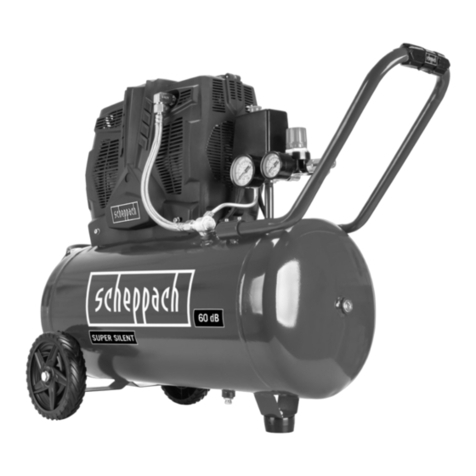
Scheppach
Scheppach HC51Si Translation of original instruction manual
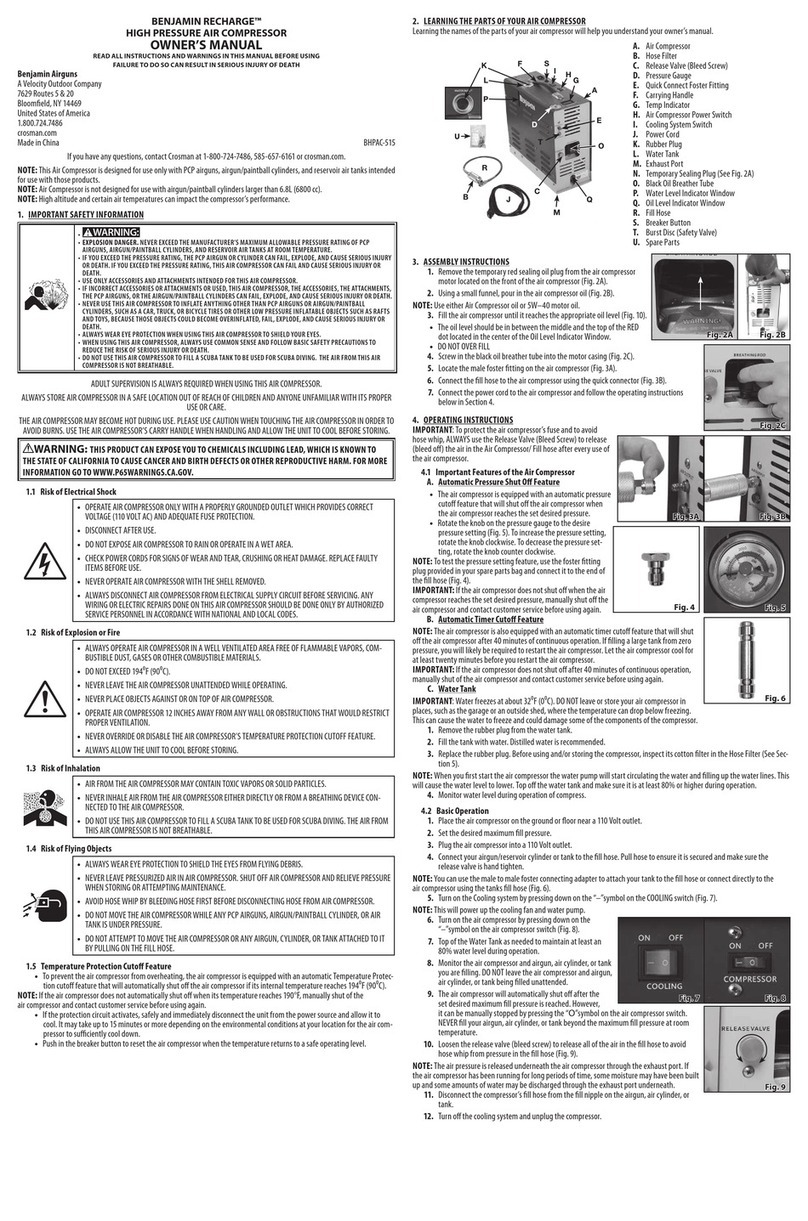
Benjamin Heating products
Benjamin Heating products RECHARGE BHPAC-515 owner's manual

Atlas Copco
Atlas Copco XAS 185 KDU T4F HOP instruction manual
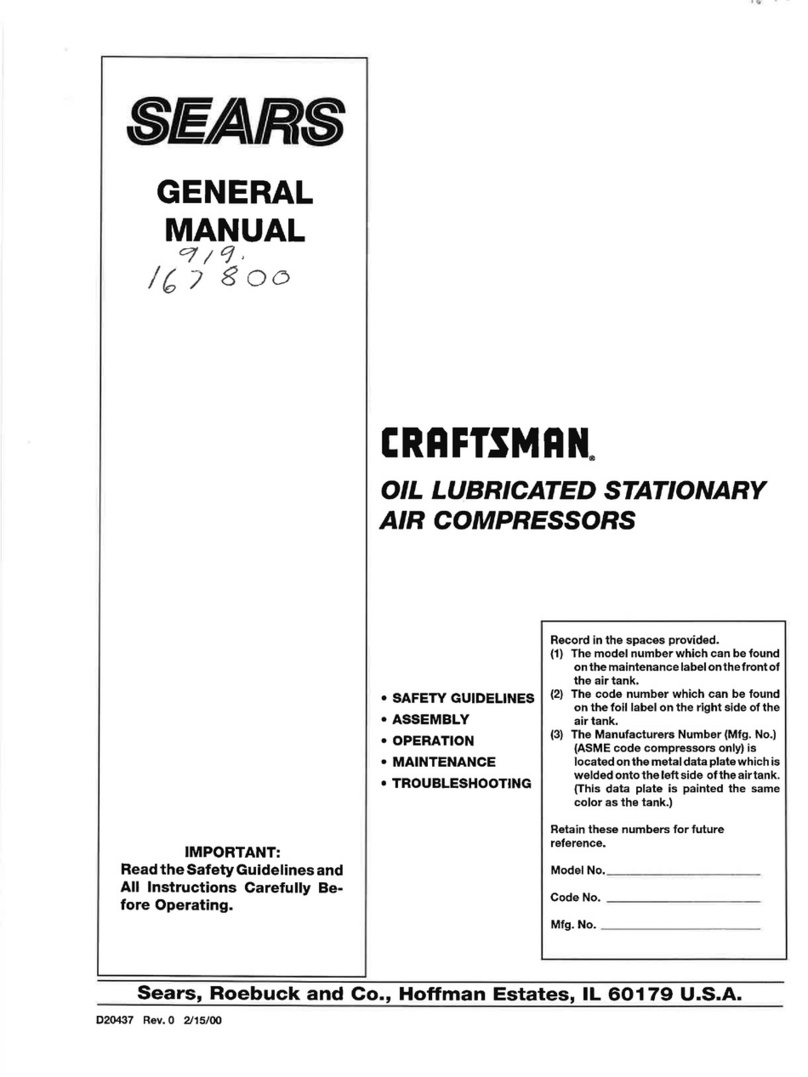
Sears
Sears Craftsman 919.167800 General manual

Nuvair
Nuvair Open Horizontal Electric MCH22 Operation manual
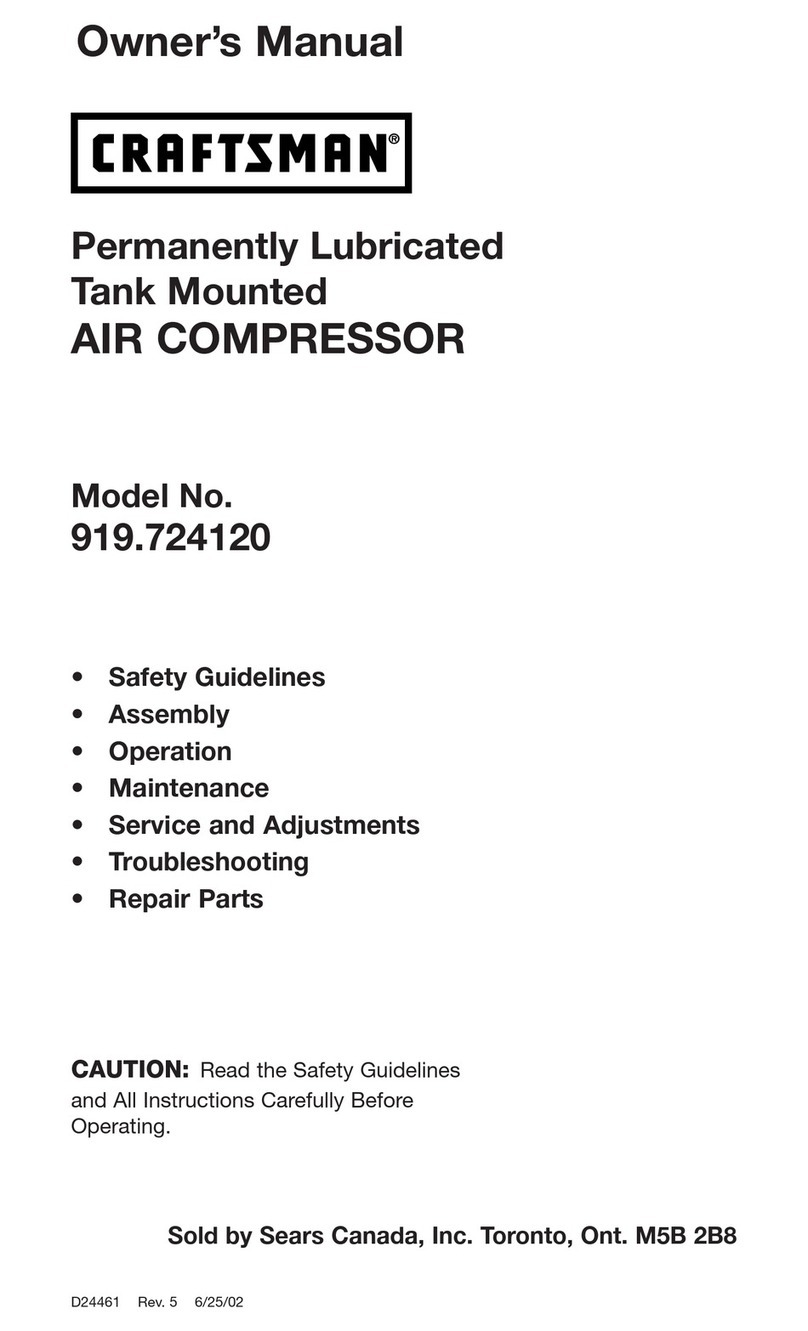
Craftsman
Craftsman 919.72412 owner's manual
